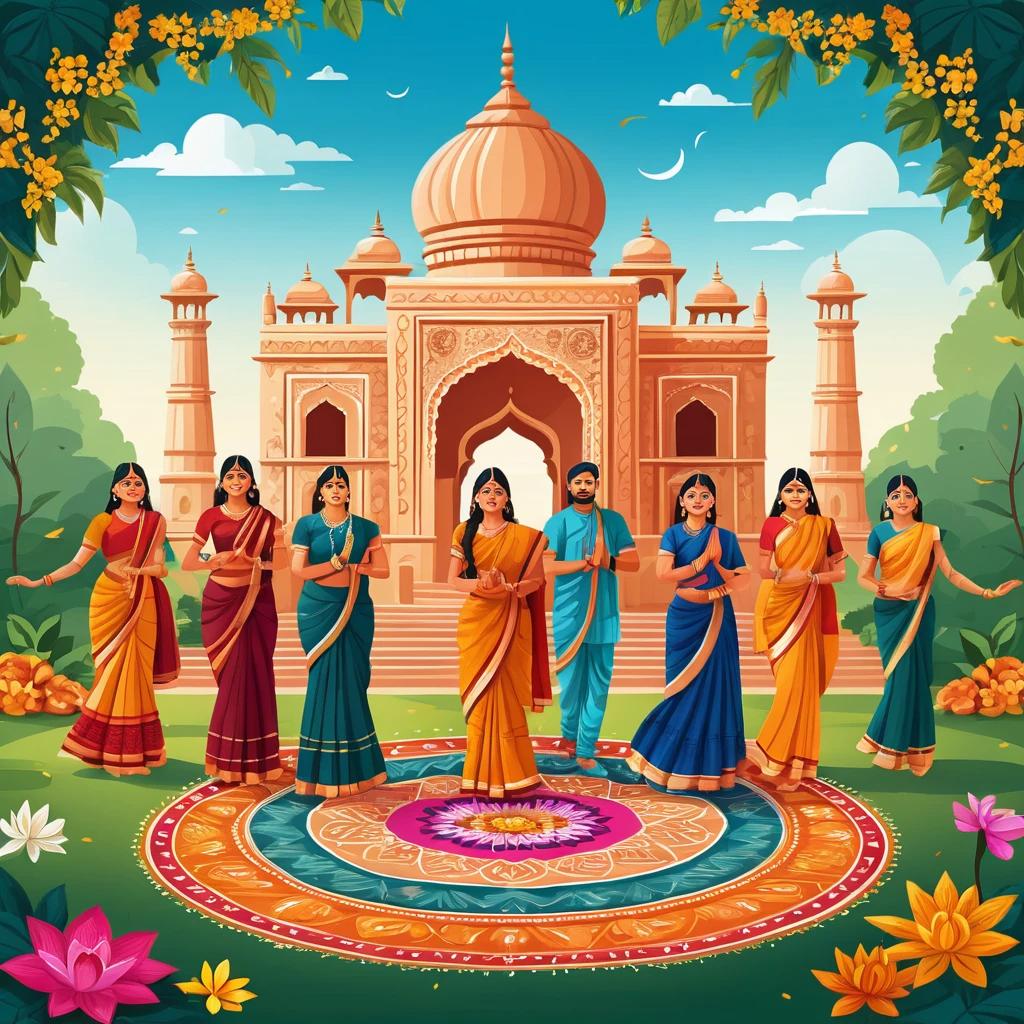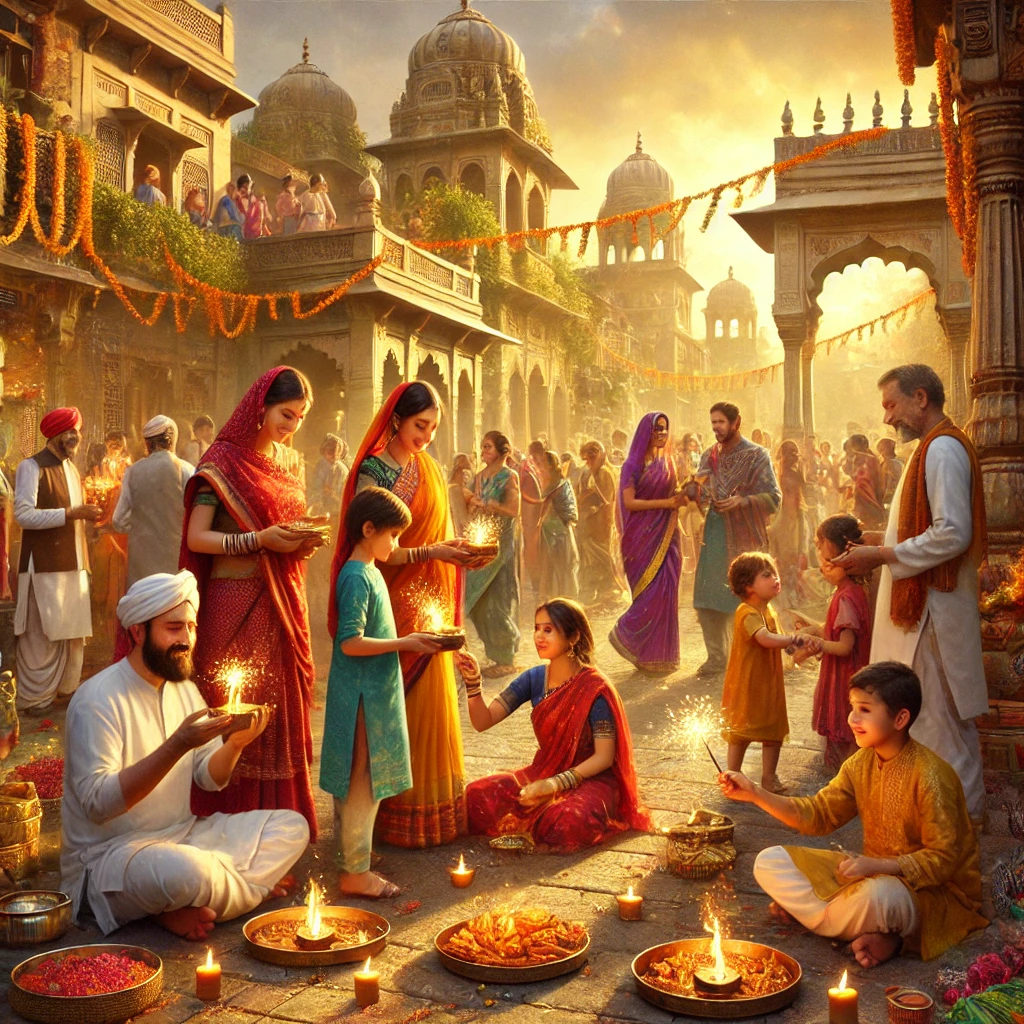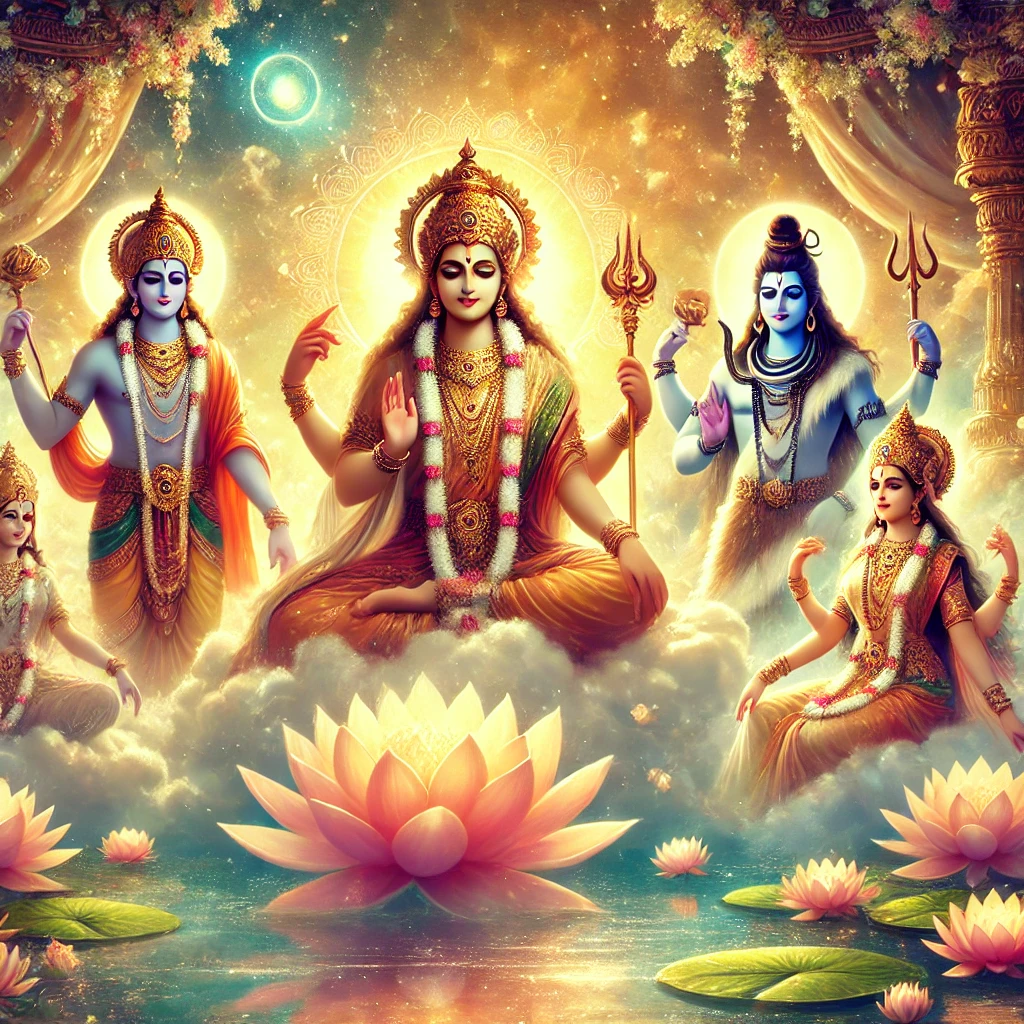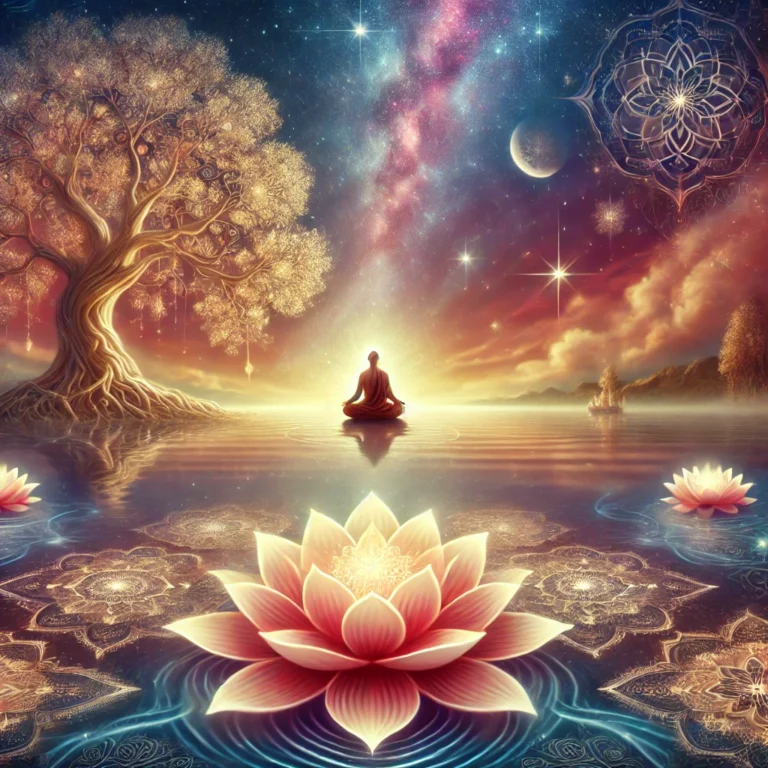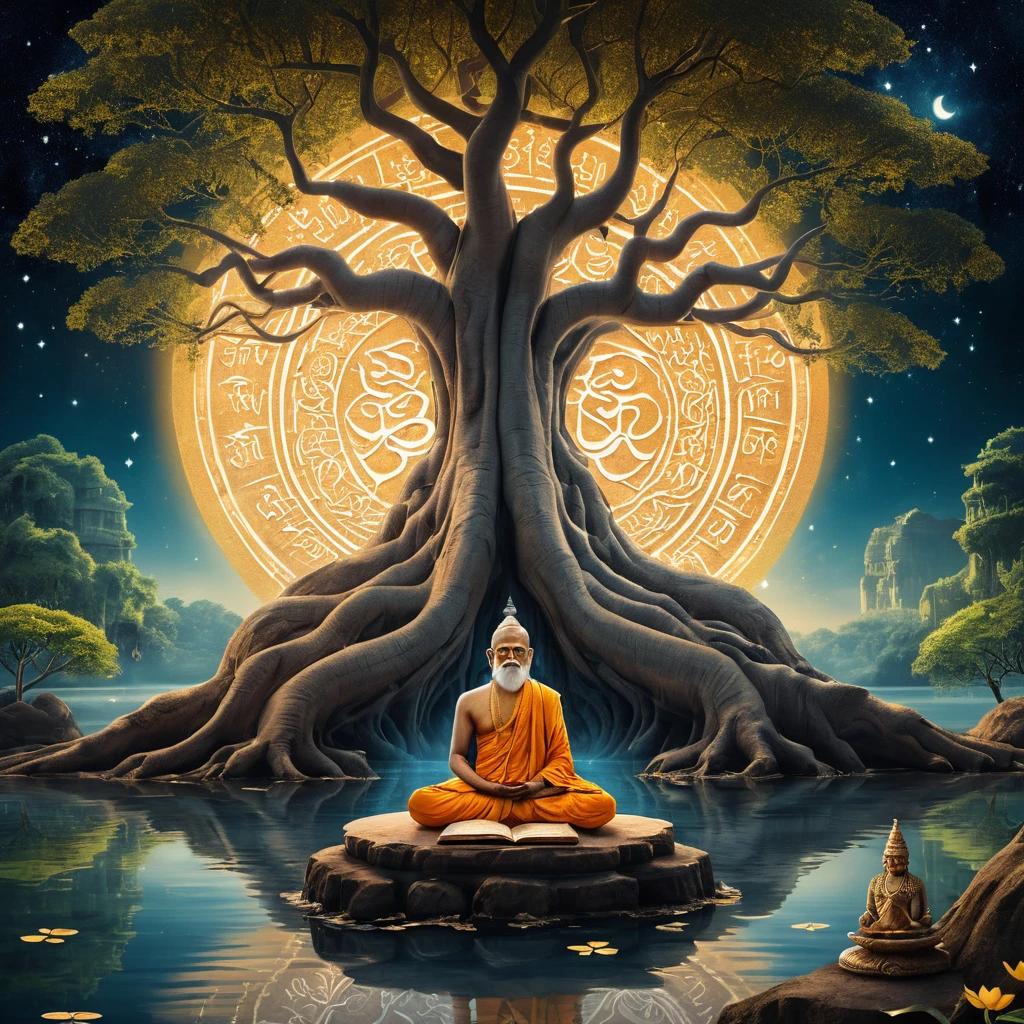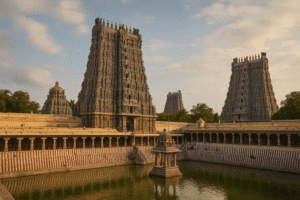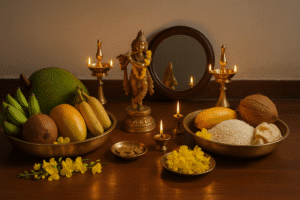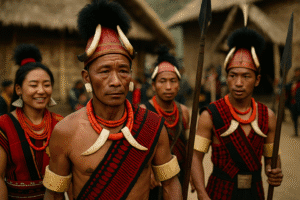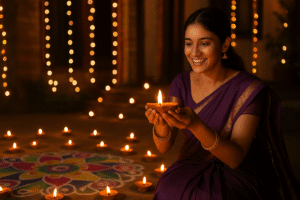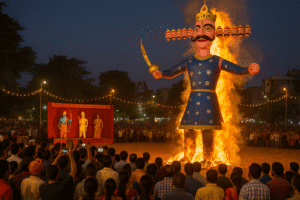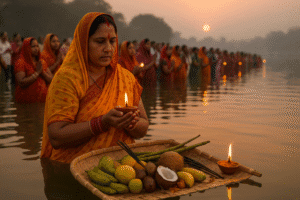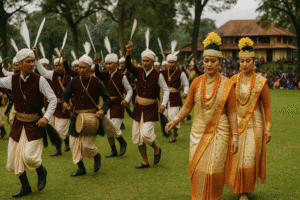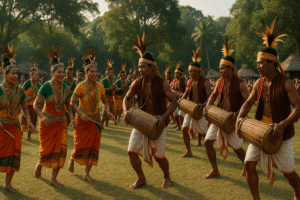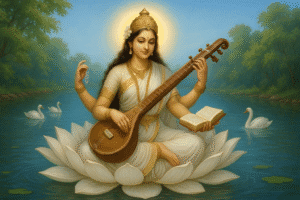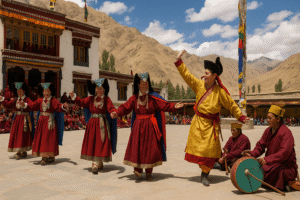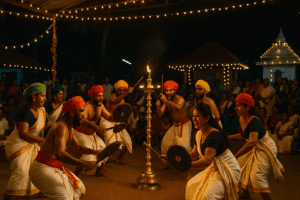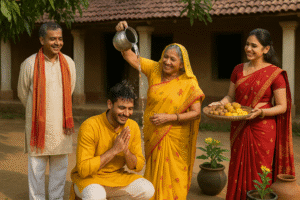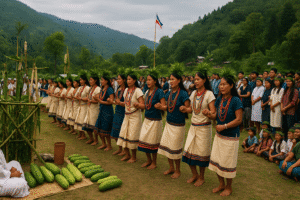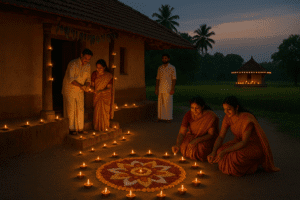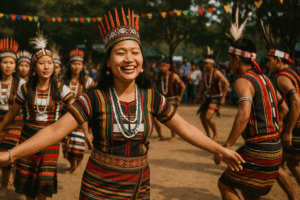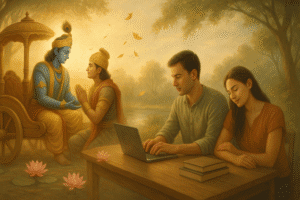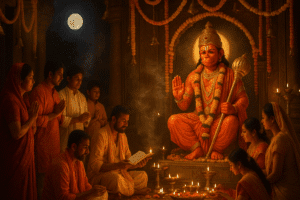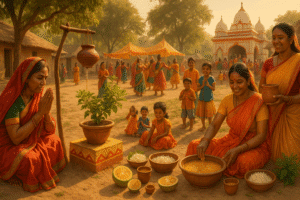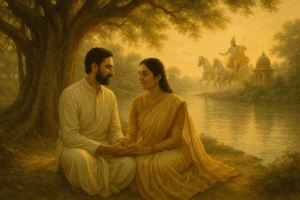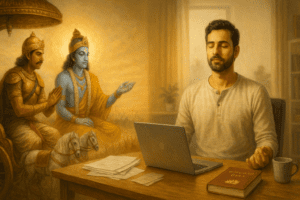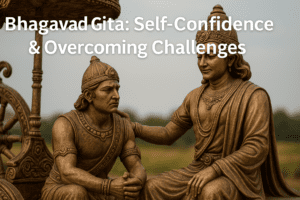Dive into the Spiritual World
Dive into the Spiritual World with Ridhya Spiritual, your gateway to exploring spirituality, ancient wisdom, traditions, and the vibrant culture of India. Begin your journey today!


Popular Categories
Latest Posts
June 21, 2025Nestled in the heart of Madurai, Tamil Nadu, the Meenakshi Temple stands as a timeless testament to India’s rich cultural heritage, architectural brilliance, and spiritual depth. Dedicated to Goddess Meenakshi (an incarnation of Parvati) and her consort Lord Sundareswarar (Shiva), this ancient temple is not just a place of worship but a vibrant symbol of Dravidian artistry and devotion. Revered as one of the most significant temples in India, it attracts millions of devotees and tourists annually, offering a glimpse into the grandeur of South Indian temple architecture and traditions. This article delves into the temple’s history, architecture, cultural significance, festivals, and enduring legacy.
1. Historical Roots of the Meenakshi Temple
The Meenakshi Temple’s origins are steeped in legend and history, tracing back to the ancient Pandya dynasty:
Mythological Beginnings: According to Hindu mythology, Goddess Meenakshi, born as Princess Tatatakasundari to the Pandya king Malayadwaja, was a divine incarnation of Parvati. She ruled Madurai and married Lord Shiva, who appeared as Sundareswarar. The temple commemorates their celestial union.
Historical Evolution: While the temple’s origins are believed to date back to the 1st century CE, the current structure was largely built between the 12th and 18th centuries under the Pandya and Nayak rulers. The Nayaks, in particular, expanded the temple complex during the 16th–17th centuries, adding iconic gopurams (towering gateways).
Archaeological Evidence: Inscriptions and texts, such as the Tiruvilaiyadal Puranam, document the temple’s prominence as a center of religion and culture in ancient Tamil Nadu.
Restoration Efforts: Over the centuries, the temple has undergone renovations to preserve its grandeur, with contributions from various rulers, devotees, and modern conservation initiatives.
2. Architectural Splendor: A Dravidian Masterpiece
The Meenakshi Temple is renowned for its awe-inspiring Dravidian architecture, characterized by intricate carvings, towering structures, and vibrant colors:
Gopurams: The temple boasts 14 gopurams, with the tallest marking the four main entrances. The southern gopuram, standing at 52 meters, is the tallest and features over 1,500 sculptures of gods, goddesses, mythical creatures, and celestial beings.
Mandapams: The temple complex houses several pillared halls, including the iconic Thousand Pillar Hall (Ayiram Kaal Mandapam), which features 985 intricately carved pillars. This hall, a marvel of engineering, also serves as a museum showcasing sculptures and artifacts.
Vimanas: The sanctum sanctorum of Goddess Meenakshi and Lord Sundareswarar is crowned with golden vimanas (towers), symbolizing divine radiance and spiritual ascendancy.
Sacred Tank: The Porthamarai Kulam (Golden Lotus Tank) within the complex is a serene water body used for ritual baths, believed to have been created by Lord Indra.
Sculptures and Paintings: Every inch of the temple is adorned with vibrant stucco images, frescoes, and stone carvings depicting scenes from Hindu mythology, showcasing unparalleled craftsmanship.
Layout: Spanning 14 acres, the temple follows a concentric layout with multiple prakarams (corridors) leading to the inner sanctums, embodying cosmic symbolism and spiritual progression.
3. Spiritual Significance
The Meenakshi Temple is a living spiritual hub, drawing devotees seeking divine blessings and inner peace:
Deities: The temple is primarily dedicated to Goddess Meenakshi, revered as the divine mother, and Lord Sundareswarar, symbolizing the eternal union of Shakti (divine feminine energy) and Shiva (divine masculine consciousness).
Daily Rituals: The temple follows a rigorous schedule of six daily pujas, accompanied by Vedic chants, music, and offerings, creating an atmosphere of divine communion.
Pilgrimage Importance: As one of the 64 Shakti Peethas (sacred abodes of the Goddess), the temple holds immense significance for devotees of Shaktism and Shaivism.
Symbolism: The temple’s architecture and rituals reflect the philosophy of harmony between human life, nature, and the divine, emphasizing devotion, discipline, and spiritual awakening.
4. Festivals and Celebrations
The Meenakshi Temple comes alive during its vibrant festivals, which blend spirituality, tradition, and community participation:
Meenakshi Thirukalyanam: Celebrated in April–May, this grand festival reenacts the divine wedding of Meenakshi and Sundareswarar. The celestial marriage, witnessed by thousands, is a highlight, with processions of deities in ornate chariots.
Chithirai Festival: This 12-day event marks the Tamil New Year and includes the coronation of Meenakshi as Madurai’s queen, followed by processions and cultural performances.
Navaratri: The nine-night festival honors the Goddess in her various forms, with the temple adorned in vibrant decorations and hosting classical music and dance performances.
Theppotsavam: The float festival, held at the Mariamman Teppakulam tank, sees the deities taken on a decorated raft, symbolizing divine grace blessing the city.
Cultural Extravaganza: These festivals showcase Tamil Nadu’s rich traditions through Bharatanatyam, Carnatic music, and folk arts, attracting artists and devotees from across India.
5. Cultural and Social Impact
Beyond its religious significance, the Meenakshi Temple has shaped Madurai’s identity as a cultural and social epicenter:
Patronage of Arts: The temple has historically supported artists, musicians, and dancers, preserving classical art forms like Bharatanatyam and Carnatic music.
Economic Hub: The temple sustains local economies by attracting tourists and pilgrims, supporting artisans, vendors, and hospitality businesses.
Social Welfare: The temple administration runs charitable initiatives, including educational institutions, hospitals, and community kitchens, reflecting its commitment to societal upliftment.
Global Recognition: Recognized as a UNESCO World Heritage tentative site, the temple is a global icon of India’s architectural and cultural legacy, inspiring awe among international visitors.
6. Modern-Day Relevance and Preservation
In the 21st century, the Meenakshi Temple remains a vibrant center of faith and heritage, adapting to modern needs while preserving its traditions:
Tourism and Accessibility: The temple is a major tourist attraction, with guided tours, multilingual signage, and digital resources enhancing visitor experiences.
Conservation Efforts: The Archaeological Survey of India (ASI) and temple authorities undertake regular restoration to protect the temple’s structures from environmental wear and urban pressures.
Digital Presence: The temple’s festivals and rituals are live-streamed, allowing global devotees to participate virtually, bridging tradition with technology.
Environmental Initiatives: Efforts like rainwater harvesting and eco-friendly practices during festivals reflect the temple’s commitment to sustainability.
7. Visiting the Meenakshi Temple: A Practical Guide
For those planning a visit, here are key tips to enhance the experience:
Timings: The temple is open from 5:00 AM to 12:30 PM and 4:00 PM to 10:00 PM, with special darshan tickets available for quicker access.
Dress Code: Modest attire covering shoulders and knees is mandatory, respecting the temple’s sanctity.
Best Time to Visit: October to March offers pleasant weather, while festival seasons provide a vibrant experience.
Etiquette: Photography is restricted in inner sanctums, and visitors are expected to maintain silence and reverence.
Nearby Attractions: Explore Madurai’s other landmarks, like the Thirumalai Nayak Palace and Vandiyur Mariamman Teppakulam, for a holistic cultural journey.
Conclusion
The Meenakshi Temple is more than a architectural marvel; it is a living embodiment of India’s spiritual, cultural, and artistic heritage. Its towering gopurams, intricate carvings, and vibrant festivals narrate stories of devotion, creativity, and resilience. As a beacon of Dravidian grandeur, the temple continues to inspire awe and reverence, inviting visitors to immerse themselves in its divine aura. Whether you seek spiritual solace, architectural wonder, or cultural immersion, the Meenakshi Temple promises an unforgettable journey into the heart of Tamil Nadu’s timeless legacy. [...]
Read more...
May 8, 2025Introduction: A Festival of New Beginnings
Vishu, the traditional New Year festival of Kerala, is a vibrant celebration marking the beginning of the Malayalam month of Medam (April). Observed with fervor across Kerala and by the Malayali diaspora worldwide, Vishu heralds the onset of spring, symbolizing prosperity, renewal, and hope. Rooted in the Hindu solar calendar, the festival coincides with the sun’s entry into Aries, aligning with other regional New Year festivals like Baisakhi and Pohela Boishakh. From the iconic Vishukkani ritual to the joyous Vishukkaineetam, Vishu weaves together spirituality, family bonding, and cultural traditions. This article explores the historical significance, rituals, culinary delights, and modern evolution of Vishu, offering a vivid glimpse into Kerala’s cultural heart.
Historical and Cultural Significance
Origins in Agrarian Traditions
Vishu’s origins lie in Kerala’s agrarian past, where the festival marked the start of the agricultural cycle after the spring equinox. Tied to the Hindu solar calendar, it celebrates the sun’s transit into Mesha (Aries), a time of abundance and renewal. Ancient texts like the Vishnu Purana emphasize the worship of Lord Vishnu, who, along with Lord Krishna, is central to Vishu’s spiritual narrative. The festival’s name, derived from the Sanskrit word “Vishuva” (equinox), underscores its celestial roots, blending Vedic astrology with Kerala’s folk traditions.
A Celebration of Prosperity
Vishu is synonymous with prosperity, reflecting Kerala’s lush landscapes and bountiful harvests. The festival’s rituals, such as Vishukkani, are believed to ensure wealth and well-being for the year ahead. Unlike temple-centric festivals, Vishu is deeply familial, with households serving as the focal point for rituals and celebrations. Its universal appeal, cutting across caste and community, makes it a unifying force in Kerala’s diverse cultural tapestry.
Rituals and Traditions: A Spiritual Awakening
Vishukkani: The Auspicious First Sight
The cornerstone of Vishu is the Vishukkani, a meticulously arranged display of auspicious items viewed at dawn on Vishu day, typically April 14 or 15. Prepared the previous night by the eldest woman of the household, the Vishukkani includes a brass uruli filled with rice, golden cucumber, coconut, areca nuts, betel leaves, a mirror, gold coins, and vibrant flowers like kanikkonna (golden shower blooms). Flanked by lit oil lamps and an idol of Lord Krishna, the arrangement is placed before a mirror to reflect abundance. Family members are led blindfolded to view the Vishukkani as their first sight of the day, believed to bring prosperity and good fortune for the year.
Vishukkaineetam: The Gift of Blessings
Another cherished tradition is Vishukkaineetam, where elders distribute money, often coins or cash, to younger family members and dependents. This ritual, performed after viewing the Vishukkani, symbolizes the sharing of wealth and blessings. Accompanied by warm embraces and greetings of “Vishu Ashamsakal” (Happy Vishu), Vishukkaineetam fosters familial bonds and communal goodwill, with children eagerly awaiting their “kaineetam” to spend on sweets or firecrackers.
Temple Visits and Spiritual Offerings
While Vishu is primarily a home-based festival, many visit temples dedicated to Lord Vishnu or Krishna, such as Guruvayur and Sabarimala, to offer prayers. Devotees light lamps and offer rice, fruits, and flowers, seeking divine blessings for the year. Special pujas, like the Vishu Phalam (astrological predictions), are conducted, with priests reading the new Panchangam (almanac) to guide devotees. These rituals blend spirituality with optimism, setting a hopeful tone for the New Year.
Cultural Performances: A Burst of Festivity
Vishu Fireworks and Village Fairs
Vishu is marked by bursts of color and sound, with fireworks lighting up the night sky in rural and urban Kerala. Villages host Vishu melas (fairs), where stalls sell toys, clay pots, and traditional sweets. Folk performances, including Kathakali, Mohiniyattam, and Theyyam, add cultural vibrancy, narrating tales from the Ramayana and Mahabharata. These events, often organized by local temples or community groups, draw crowds, fostering a sense of shared celebration.
Traditional Games and Community Bonding
In rural Kerala, Vishu brings communities together through traditional games like Uri Adi (pot-breaking), Vadamvali (tug-of-war), and Nadan Pattu (folk song competitions). These activities, enjoyed by young and old, strengthen social ties and evoke nostalgia. The laughter and cheers echoing through villages underscore Vishu’s role as a festival of joy and togetherness.
Culinary Delights: A Feast for the Senses
Vishu Sadya: A Grand Feast
No Vishu is complete without the Vishu Sadya, a lavish vegetarian feast served on banana leaves. Comprising over 20 dishes, the sadya features rice with sambar, rasam, avial (mixed vegetable curry), thoran (stir-fried vegetables), and olan (ash gourd in coconut milk). The star of the meal is payasam, a sweet kheer made with jaggery, rice, or vermicelli, often flavored with cardamom and cashews. The sadya’s balance of sweet, sour, and spicy flavors reflects Kerala’s culinary finesse, with families gathering to savor the meal post-Vishukkani.
Vishu Specialties
Beyond the sadya, Vishu features unique dishes like Vishu Kanji, a rice porridge with mung beans and coconut milk, and Mambazha Pulissery, a tangy mango curry. Jackfruit and mangoes, in season during Vishu, appear in erissery and pachadi, adding tropical flair. These dishes, prepared with fresh, local ingredients, celebrate Kerala’s agrarian bounty and reinforce the festival’s focus on abundance.
The Setting: Kerala’s Lush Backdrop
A Festival Amid Nature’s Splendor
Vishu unfolds against Kerala’s verdant landscapes, with coconut groves, paddy fields, and blooming kanikkonna trees setting a picturesque stage. Homes are adorned with kolam (rangoli) made of rice flour and flowers, and doorways are framed with mango leaves, symbolizing prosperity. The early morning air, filled with the scent of jasmine and the glow of oil lamps, creates a serene ambiance for the Vishukkani ritual, grounding the festival in nature’s embrace.
Accessibility and Celebration Hubs
Major Vishu celebrations occur in cities like Thrissur, Kochi, and Thiruvananthapuram, with temples and cultural centers hosting events. Thrissur’s Vadakkumnathan Temple and Kochi’s Paramekkavu Temple draw devotees, while rural areas like Palakkad and Kottayam host vibrant melas. For travelers, Kerala’s well-connected roads and Cochin International Airport make Vishu an accessible cultural experience, with homestays offering immersive stays.
Modern Evolution: A Global Malayali Festival
Vishu Beyond Kerala
Vishu has transcended Kerala’s borders, with Malayali communities celebrating in cities like Bengaluru, Mumbai, Dubai, and London. In 2025, Vishu falls on April 14, and diaspora events are planned in community halls and temples worldwide, featuring Vishukkani displays and sadya feasts. Social media platforms amplify the festival’s reach, with families sharing Vishukkani photos and recipes online, fostering a global Malayali identity.
Adapting Traditions
While Vishu retains its traditional core, modern adaptations include eco-friendly fireworks and digital Vishukkaineetam via mobile apps. Urban families, constrained by space, create compact Vishukkani arrangements, yet preserve the ritual’s sanctity. Community organizations host Vishu cultural programs, blending classical and contemporary performances to engage younger generations, ensuring the festival’s relevance in a fast-changing world.
Vishu in Context: A Solar New Year
A Shared Celestial Celebration
Vishu is part of a broader tapestry of solar New Year festivals across South Asia, including Tamil Puthandu, Assamese Bohag Bihu, and Bengali Pohela Boishakh, all tied to the sun’s entry into Aries. Unlike lunar-based festivals like Ugadi, Vishu’s solar alignment emphasizes its universal appeal. Its focus on familial rituals and prosperity distinguishes it from temple-centric celebrations, highlighting Kerala’s unique cultural ethos.
A Festival of Optimism
Vishu’s emphasis on the “first sight” of abundance sets a positive tone for the year, resonating with universal themes of hope and renewal. The Vishukkani’s mirror, reflecting prosperity, symbolizes self-reflection and optimism, making Vishu a deeply personal yet communal celebration. Its blend of spirituality and festivity appeals to all ages, cementing its place in Kerala’s cultural calendar.
Conclusion: A Beacon of Joy and Prosperity
Vishu is more than a New Year festival; it is a radiant celebration of Kerala’s soul, weaving together faith, family, and festivity. From the serene beauty of the Vishukkani to the joyous bursts of Vishukkaineetam, every ritual pulses with hope and gratitude. As families gather for the sadya and villages come alive with fireworks, Vishu fosters unity and optimism, honoring the land’s bounty and the promise of new beginnings. Whether in a Kerala village or a diaspora community abroad, Vishu’s glow transcends borders, inviting all to embrace prosperity and joy. As the kanikkonna blooms and lamps flicker at dawn, Vishu reminds us to look forward with faith, celebrating life’s endless possibilities. [...]
Read more...
May 8, 2025Introduction: A Vibrant Mosaic of Naga Culture
The Hornbill Festival, often dubbed the “Festival of Festivals,” is Nagaland’s grandest cultural extravaganza, showcasing the rich heritage of its 17 major Naga tribes. Held annually from December 1 to 10 at the Naga Heritage Village, Kisama, near Kohima, this 10-day event is a dazzling celebration of tribal traditions, unity, and Northeast India’s vibrant diversity. Named after the majestic hornbill bird, revered in Naga folklore, the festival blends ancient customs with modern festivity, attracting thousands of locals, tourists, and global culture enthusiasts. From mesmerizing war dances to soulful folk music, the Hornbill Festival is a living testament to Nagaland’s indomitable spirit. This article explores the festival’s history, cultural performances, culinary delights, and modern significance, offering a vivid journey into the heart of Naga heritage.
Historical Roots: A Celebration of Naga Identity
Origins in Tribal Traditions
The Hornbill Festival, launched in 2000 by the Nagaland government, draws inspiration from the ancient tribal festivals of the Naga people, who have inhabited the region for centuries. Each tribe, from the Angami to the Zeliang, historically celebrated its own festivals, such as Sekrenyi, Ngada, and Moatsu, tied to agriculture, harvest, and community bonding. The Hornbill Festival unifies these diverse celebrations under one platform, preserving tribal customs while fostering intertribal harmony. Named after the hornbill, a bird symbolizing strength and fidelity in Naga folklore, the festival reflects the tribes’ deep connection to nature and their warrior ethos.
A Platform for Unity and Tourism
Conceived to promote Nagaland’s cultural heritage and boost tourism, the Hornbill Festival has grown into a global phenomenon. Organized by the Nagaland State Tourism and Art & Culture Departments, it transforms Kisama into a cultural hub, showcasing the state’s 17 tribes and their unique traditions. The festival’s timing in early December, amidst Nagaland’s misty hills, aligns with the post-harvest season, echoing the tribes’ agrarian roots. Over the years, it has become a symbol of Naga pride, drawing parallels with other indigenous festivals like Brazil’s Carnival or Scotland’s Highland Games.
Cultural Performances: A Showcase of Tribal Splendor
War Dances and Folk Songs
The Hornbill Festival is renowned for its electrifying war dances, performed by tribes like the Ao, Konyak, and Sumi. Dancers, adorned in traditional warrior attire with feathered headdresses, hornbill feathers, and beadwork, reenact battle movements with spears and daos (machetes). The rhythmic stomping, accompanied by log drums and bamboo trumpets, creates a visceral energy. Folk songs, sung in tribal dialects, narrate tales of valor, love, and harvest, with groups like the Chakhesang singers captivating audiences with their haunting melodies. These performances, rooted in centuries-old traditions, are both a cultural archive and a visual spectacle.
Morungs and Tribal Exhibits
Each Naga tribe sets up a morung (traditional dormitory) at Kisama, replicating their ancestral architecture. These bamboo-and-thatch structures serve as cultural hubs, where elders share oral histories, artisans display crafts, and youth perform rituals. Visitors can witness live demonstrations of weaving, woodcarving, and basket-making, alongside exhibits of tribal weaponry and jewelry. The morungs, such as the Konyak’s headhunter-themed pavilion, offer an immersive glimpse into Naga life, fostering cross-cultural understanding.
Indigenous Games and Competitions
The festival features traditional games like bamboo stilt races, king chili-eating contests (using the fiery Bhut Jolokia), and Naga wrestling, showcasing physical prowess and tribal camaraderie. The Hornbill International Rock Contest and Motorcycle Rally add a modern twist, drawing youth and adventure enthusiasts. These events, blending tradition with contemporary flair, ensure the festival appeals to all ages, making Kisama a vibrant cultural playground.
Traditional Attire: A Tapestry of Tribal Artistry
Warrior Finery and Ornaments
Naga attire during the Hornbill Festival is a visual feast, reflecting each tribe’s distinct identity. Men wear shawls like the Angami’s black-and-red Tsudon or the Ao’s blue Rongsu, paired with hornbill feather headdresses and boar-tusk necklaces. Women don colorful skirts, beaded belts, and shawls, such as the Zeliang’s vibrant Mekhela, accessorized with shell and coral jewelry. The Konyak warriors, once headhunters, sport facial tattoos and cane helmets, evoking their fierce legacy. These handmade garments, woven by tribal women, showcase Nagaland’s textile heritage and cultural pride.
Preserving Craftsmanship
The festival provides a platform for artisans to display their weaving and beadwork, passed down through generations. Initiatives like the Hornbill Craft Bazaar encourage young Nagas to learn these skills, ensuring their survival amidst modernization. Visitors can purchase shawls, baskets, and jewelry, supporting local economies and preserving Naga craftsmanship for future generations.
Culinary Delights: Savoring Naga Flavors
The Hornbill Festival is a culinary adventure, with food stalls offering authentic Naga cuisine. Dishes like smoked pork with bamboo shoots, axone (fermented soybean) curry, and galho (rice-vegetable stew) highlight the tribes’ bold, smoky flavors. Vegetarian options include anishi (fermented yam leaves) and boiled greens with ginger. Local brews like zutho (rice beer) and raksi (millet liquor) add a festive kick. The king chili, one of the world’s hottest, features in chutneys, daring visitors to test their spice tolerance. These communal meals, served in bamboo plates, foster a sense of shared joy, blending tradition with gastronomic exploration.
The Setting: Kisama’s Cultural Haven
Naga Heritage Village, Kisama
The Naga Heritage Village at Kisama, 12 km from Kohima, is the festival’s permanent venue, designed to replicate a traditional Naga hamlet. Surrounded by rolling hills and mist-covered valleys, the site features morungs, an amphitheater, and open-air stages. The serene yet vibrant setting, with log drum houses and stone pathways, enhances the festival’s authenticity. Nightly events under starlit skies, including music concerts and bonfires, create an enchanting ambiance, making Kisama a cultural pilgrimage site.
Accessibility and Visitor Tips
Kisama is accessible via NH-2 from Dimapur (70 km) or Kohima, with Dibrugarh Airport (220 km) as the nearest air link. Visitors can reach Kohima by train to Dimapur or bus from Guwahati. Entry to the festival is free, though premium events like the rock contest may require tickets (₹200–₹500). Travelers are advised to book accommodations in Kohima or homestays in Khonoma village early, wear warm clothing for December’s chill, and respect Naga customs, such as seeking permission before photographing rituals. The festival’s eco-friendly ethos encourages minimal plastic use, aligning with Nagaland’s sustainable tourism goals.
Modern Significance: A Global Cultural Beacon
Tourism and Global Reach
The Hornbill Festival has become a global draw, with the 2024 edition (December 1–10) attracting over 200,000 visitors, including tourists from Japan, the UK, and Australia. Supported by the Nagaland government and UNESCO, it promotes Northeast India as a cultural hotspot. Social media amplifies its allure, with hashtags like #HornbillFestival trending during the event. International performers, such as Korean bands in 2023, add a global dimension, fostering cultural exchange while spotlighting Naga traditions.
Preserving Heritage Amid Modernity
The festival plays a vital role in preserving Naga culture, encouraging youth to embrace their roots through dance, craft, and storytelling. Initiatives like the Hornbill Literature Festival and PhotoFest engage younger audiences, blending tradition with contemporary platforms. Despite challenges like urbanization and Christian influence (Nagaland is 90% Christian), the festival retains its animistic and tribal essence, with tribes like the Konyak and Chang showcasing pre-Christian rituals. Community-led efforts ensure sustainable practices, such as waste management and local sourcing, keeping the festival vibrant yet authentic.
Hornbill in Context: A Unique Tribal Celebration
A Northeast Indian Gem
The Hornbill Festival shares parallels with other Northeast festivals like Manipur’s Sangai Festival and Meghalaya’s Wangala, all celebrating indigenous heritage. However, its scale, uniting 17 tribes under one banner, and its focus on intertribal harmony make it unique. Unlike single-tribe festivals like the Ao’s Moatsu, Hornbill’s diversity mirrors Nagaland’s multicultural ethos, earning it the title “Festival of Festivals.”
A Celebration of Unity and Resilience
The festival’s emphasis on unity reflects Nagaland’s journey from conflict to peace, showcasing the Naga’s resilience and pride. Its blend of ancient war dances with modern rock concerts symbolizes a bridge between past and present, appealing to global audiences while honoring tribal roots. The hornbill’s symbolism—strength and fidelity—resonates universally, making the festival a celebration of human spirit and cultural diversity.
Conclusion: A Timeless Naga Legacy
The Hornbill Festival is a radiant celebration of Nagaland’s soul, where ancient traditions and modern festivity converge amidst the misty hills of Kisama. From the thunderous war dances to the soulful folk songs, every performance pulses with pride and heritage. As tribes gather in their morungs, sharing zutho and stories, the festival weaves a tapestry of unity, resilience, and joy. Whether you’re a cultural explorer, a music enthusiast, or a traveler seeking authenticity, Hornbill offers an unforgettable immersion into Naga life. As the log drums fade and the hornbill feathers glisten under the winter sun, the festival leaves a timeless message: to honor the past, embrace diversity, and celebrate the vibrant spirit of humanity. [...]
Read more...
May 8, 2025Introduction: A Celebration of Radiance and Renewal
Diwali, known as Deepavali or the Festival of Lights, is India’s most cherished and widely celebrated festival, illuminating homes, hearts, and communities with the glow of hope and togetherness. Observed by Hindus, Jains, Sikhs, and Buddhists, Diwali typically falls in October or November, based on the lunar calendar, marking the triumph of light over darkness and good over evil. From the flickering of clay diyas to the burst of fireworks, Diwali is a five-day extravaganza of rituals, feasts, and cultural vibrancy. Rooted in ancient traditions and diverse mythologies, it transcends religious and regional boundaries, uniting millions across India and the global diaspora. This article delves into the historical significance, rituals, culinary delights, and modern evolution of Diwali, capturing its timeless magic.
Historical and Spiritual Significance
Mythological Roots: Triumph of Good
Diwali’s origins are steeped in Hindu epics, with the most prominent legend tied to the Ramayana. The festival celebrates Lord Rama’s return to Ayodhya after 14 years of exile and his victory over the demon king Ravana, symbolizing the triumph of righteousness. In South India, Diwali honors Lord Krishna’s defeat of the demon Narakasura, while Jains commemorate Lord Mahavira’s attainment of nirvana. For Sikhs, Diwali marks the release of Guru Hargobind Ji from Mughal captivity, signifying freedom and justice. These diverse narratives converge on a universal theme: the victory of light, knowledge, and virtue over darkness and ignorance.
A Celestial Alignment
Diwali coincides with the new moon (Amavasya) of the Hindu month of Kartik, a time when the night sky is at its darkest, making the glow of lamps profoundly symbolic. Ancient texts like the Skanda Purana emphasize the worship of Goddess Lakshmi, the deity of wealth, and Lord Ganesha, the remover of obstacles, during Diwali. The festival’s celestial and spiritual alignment fosters a sense of renewal, encouraging devotees to cleanse their homes, minds, and hearts for a prosperous year ahead.
The Five Days of Diwali: A Journey of Joy
Day 1: Dhanteras – The Dawn of Prosperity
Diwali begins with Dhanteras, the day dedicated to wealth and health. Devotees worship Goddess Lakshmi and Lord Dhanvantari, the god of Ayurveda, praying for abundance and well-being. Homes are cleaned, and new purchases—gold, silver, utensils, or appliances—are made, as buying metal is considered auspicious. The lighting of a single diya at the doorstep marks the start of festivities, inviting prosperity. In 2024, Dhanteras was celebrated on October 29, with markets buzzing with shoppers seeking “Dhan” (wealth).
Day 2: Naraka Chaturdasi – The Cleansing Ritual
The second day, known as Naraka Chaturdasi or Choti Diwali, commemorates Krishna’s victory over Narakasura. Devotees rise before dawn for an oil bath, symbolizing spiritual purification. Homes are adorned with rangoli (colorful patterns) and lit with diyas to ward off evil. In some regions, like Maharashtra, effigies of Narakasura are burned, echoing the triumph of good. This day, observed on October 30, 2024, sets a reflective tone, blending cleansing rituals with festive preparations.
Day 3: Diwali – The Night of Lights
The third day, the main Diwali night (October 31, 2024), is the festival’s crescendo. Families gather to perform Lakshmi-Ganesha puja, offering sweets, flowers, and coins to invite wealth and wisdom. Homes glow with rows of clay diyas, fairy lights, and lanterns, while fireworks illuminate the sky, symbolizing the banishment of darkness. The exchange of gifts—sweets, dry fruits, and clothes—strengthens bonds, and card games add playful cheer. The night, filled with laughter and light, embodies Diwali’s core message of joy and unity.
Day 4: Annakut – The Feast of Abundance
The fourth day, Annakut or Govardhan Puja, celebrates Lord Krishna’s lifting of the Govardhan Hill to protect villagers from Indra’s wrath. Devotees prepare an array of dishes, known as “Annakut” (mountain of food), offered to Krishna in temples and homes. In North India, this day, observed on November 1, 2024, is also marked as Vishwakarma Day, honoring the divine architect. The sharing of lavish meals reinforces gratitude for nature’s bounty and communal harmony.
Day 5: Bhai Dooj – The Bond of Siblings
Diwali concludes with Bhai Dooj, a heartfelt celebration of sibling love. Sisters apply tilak (vermilion) on their brothers’ foreheads, praying for their long life, while brothers offer gifts in return. Rooted in the legend of Yama and his sister Yamuna, this day, celebrated on November 2, 2024, strengthens familial ties. The ritual, akin to Raksha Bandhan, underscores Diwali’s emphasis on relationships, wrapping the festival in warmth and affection.
Cultural Performances: A Burst of Art and Tradition
Rangoli and Fireworks: Visual Splendor
Diwali transforms India into a canvas of creativity, with intricate rangoli designs adorning doorsteps, made from colored powders, rice, or flowers. These patterns, often featuring lotuses or peacocks, welcome Lakshmi and enhance the festive aesthetic. Fireworks, from sparklers to aerial displays, light up the night, though growing environmental awareness has spurred eco-friendly alternatives like laser shows. In 2024, cities like Delhi promoted green crackers to reduce pollution, balancing tradition with sustainability.
Music, Dance, and Community Events
Diwali sparks cultural vibrancy, with community fairs hosting folk dances like Garba and Dandiya in Gujarat, and classical performances in urban centers. Bollywood Diwali songs, from “Diwali Aayi” to “Happy Diwali,” fill the air, while temples organize bhajans and kirtans. Mela stalls sell handicrafts, diyas, and sweets, fostering local economies. These events, blending tradition with festivity, create a joyous atmosphere, uniting diverse communities in celebration.
Culinary Delights: A Feast of Sweet and Savory
Diwali is a gastronomic delight, with sweets and snacks at its heart. Classics like laddoo, barfi, jalebi, and gulab jamun, made with ghee, sugar, and nuts, symbolize sweetness in life. Savory treats include chakli, sev, and mathri, perfect for festive snacking. Regional specialties shine—Bengali sandesh, Maharashtrian karanji, and South Indian mysore pak add diversity. Families exchange mithai boxes, and home-cooked feasts feature biryani, paneer curries, and puri-sabzi, fostering communal dining. In 2024, artisanal sweets with organic ingredients gained popularity, reflecting modern tastes.
The Setting: India’s Illuminated Landscape
Homes and Streets Aglow
Diwali transforms India’s cities and villages into a sea of lights. Homes are cleaned, whitewashed, and decorated with diyas, torans (door hangings), and fairy lights. Urban centers like Mumbai’s Marine Drive and Delhi’s Chandni Chowk sparkle, while rural hamlets glow with earthen lamps. Temples, such as Varanasi’s Kashi Vishwanath and Amritsar’s Golden Temple, host grand celebrations, drawing devotees. The festival’s visual splendor, set against India’s diverse landscapes, creates an enchanting ambiance.
Accessibility and Global Celebrations
Major Diwali events occur in cities like Delhi, Kolkata, and Bengaluru, with public displays at India Gate and Cubbon Park. For travelers, Delhi’s airports and India’s extensive rail network make access easy. The diaspora celebrates Diwali in London’s Trafalgar Square, New York’s Times Square, and Sydney’s Parramatta, with lamp-lighting and cultural shows. In 2024, over 50 countries hosted Diwali events, showcasing its global footprint.
Modern Evolution: A Festival of Sustainability and Inclusion
Eco-Friendly Diwali
Diwali’s environmental impact, particularly from fireworks, has spurred a shift toward sustainability. In 2024, campaigns like “Green Diwali” promoted diyas over electric lights, plantable crackers, and community clean-ups. Cities like Bengaluru hosted zero-waste Diwali bazaars, selling biodegradable decor. Social media amplified eco-conscious practices, with influencers sharing DIY rangoli and upcycled diya tutorials, ensuring the festival evolves responsibly.
A Global and Inclusive Celebration
Diwali’s universal themes of light and unity resonate worldwide, with non-Hindus joining celebrations in multicultural hubs like Toronto and Dubai. In 2024, the White House Diwali event, attended by Indian-American leaders, highlighted its diplomatic significance. Virtual pujas and online gift exchanges, popularized post-COVID, connect the diaspora, while corporate Diwali parties and school events engage younger generations, ensuring the festival’s relevance in a globalized world.
Diwali in Context: A Universal Festival of Light
Shared Themes Across Cultures
Diwali shares parallels with global light festivals like Hanukkah, Christmas, and Thailand’s Loy Krathong, all celebrating hope and renewal. Its lunar timing and focus on family align with harvest festivals like Pongal and Bihu, yet its pan-Indian and interfaith appeal make it unique. The festival’s adaptability, embracing Jain, Sikh, and Buddhist narratives, underscores its inclusivity, uniting India’s diverse communities.
A Celebration of Resilience
Diwali’s message—light over darkness—resonates in times of adversity. During the 2020 pandemic, virtual Diwali celebrations and balcony diya-lighting fostered hope. The festival’s emphasis on renewal inspires personal growth, encouraging devotees to overcome challenges with optimism. Its blend of spirituality, festivity, and community spirit cements Diwali as a timeless celebration of human resilience.
Conclusion: A Beacon of Light and Love
Diwali is more than a festival; it is India’s radiant heartbeat, illuminating lives with faith, joy, and unity. From the glow of diyas to the sweetness of laddoos, every ritual weaves a story of hope and togetherness. As families gather, fireworks soar, and rangoli bloom, Diwali transcends borders, inviting all to embrace light over darkness. Whether in a bustling Indian city or a quiet diaspora home, the festival’s magic endures, fostering love, generosity, and renewal. As we light a diya this Diwali, let us celebrate the eternal promise of a brighter tomorrow, united in the glow of shared humanity. [...]
Read more...
May 8, 2025Introduction: A Festival of Triumph and Renewal
Dussehra, also known as Vijayadashami, is one of India’s most vibrant and revered festivals, marking the triumph of good over evil. Celebrated on the tenth day of the Hindu month of Ashwin (September–October), Dussehra concludes the nine-day Navratri festival with a spectacular display of devotion, cultural performances, and communal joy. Rooted in the epic Ramayana, it commemorates Lord Rama’s victory over the demon king Ravana, symbolizing righteousness prevailing over malevolence. From the towering effigy burnings of North India to the intricate rituals of South India, Dussehra unites diverse communities in a shared celebration of virtue and renewal. This article explores the historical significance, rituals, regional variations, and modern evolution of Dussehra, capturing its timeless resonance across India and beyond.
Historical and Spiritual Significance
Mythological Foundations: The Ramayana Legacy
Dussehra’s core narrative stems from the Ramayana, where Lord Rama, aided by his wife Sita, brother Lakshmana, and devotee Hanuman, defeats Ravana, the ten-headed demon king of Lanka. This victory, celebrated on the tenth day, signifies the restoration of dharma (righteousness). Another legend ties Dussehra to Goddess Durga’s triumph over the buffalo demon Mahishasura, marking the culmination of Navratri. For some communities, it also honors Arjuna’s victory in the Mahabharata, as he retrieved his weapons on this day. These stories converge on a universal theme: the eternal triumph of good over evil, making Dussehra a festival of moral and spiritual renewal.
A Celestial Milestone
Dussehra falls on the tenth day (Dashami) of the bright half of Ashwin, aligned with the lunar calendar, typically in late September or early October. In 2024, it was celebrated on October 12, following Navratri’s nine nights of worship. The day is considered highly auspicious, believed to amplify the success of new ventures, learning, and spiritual pursuits. Ancient texts like the Devi Bhagavata Purana emphasize Vijayadashami as a time to honor wisdom, courage, and divine feminine energy, embodied by Durga and Rama’s valor.
Rituals and Traditions: A Tapestry of Devotion
Ramlila: The Epic Enacted
In North India, Dussehra is synonymous with Ramlila, a dramatic reenactment of the Ramayana performed over ten days. Communities stage vibrant plays in open grounds, with actors portraying Rama, Sita, and Ravana. The finale on Dussehra features the burning of massive effigies of Ravana, Kumbhakarna, and Meghnad, stuffed with fireworks, symbolizing the destruction of evil. Iconic Ramlilas, like those in Delhi’s Ramlila Maidan and Varanasi’s Ramnagar, draw thousands, blending devotion with theatrical grandeur. In 2024, eco-friendly effigies made with biodegradable materials gained traction, reflecting environmental consciousness.
Durga Visarjan: Farewell to the Goddess
In East and South India, Dussehra marks the immersion (visarjan) of Goddess Durga’s idols, concluding Navratri. In West Bengal, intricately crafted Durga pandals are dismantled, and idols are immersed in rivers or seas, accompanied by sindoor khela, where married women smear vermilion on each other, celebrating feminine power. In Odisha and Karnataka, the focus shifts to Saraswati and Lakshmi puja, with books and tools worshipped to invoke wisdom and prosperity. These rituals, rich in regional flavor, underscore Dussehra’s multifaceted spiritual significance.
Ayudha Puja and Vidyarambham: Honoring Tools and Learning
In South India, particularly Karnataka, Tamil Nadu, and Kerala, Dussehra is celebrated as Ayudha Puja, where tools, weapons, and books are cleaned, decorated with sandalwood paste and flowers, and worshipped. Farmers honor plows, artisans their tools, and students their books, seeking divine blessings for success. In Kerala, Vidyarambham introduces young children to learning, with priests or elders guiding them to write their first letters on rice or sand, symbolizing the start of education. These rituals highlight Dussehra’s role as a day of beginnings and reverence for knowledge.
Regional Variations: A Kaleidoscope of Celebrations
North India: Effigies and Fireworks
In states like Uttar Pradesh, Punjab, and Himachal Pradesh, Dussehra is a spectacle of towering Ravana effigies set ablaze amid fireworks. Kullu Dussehra in Himachal Pradesh, a week-long festival, features a unique procession of deities carried in palanquins, drawing global tourists. The vibrant fairs, with Ferris wheels and food stalls, add a carnival-like atmosphere, making North India’s Dussehra a blend of devotion and festivity.
East India: Durga’s Grand Farewell
In West Bengal, Odisha, and Assam, Dussehra is the emotional climax of Durga Puja. Kolkata’s streets come alive with processions, drumbeats, and tearful farewells as Durga idols are immersed. Community feasts feature bhog (prasad) like khichdi and payesh (rice pudding). In Cuttack, silver and gold filigree tableaux enhance the grandeur, showcasing Odisha’s craftsmanship. These celebrations emphasize communal unity and artistic expression.
South India: Mysore’s Royal Splendor
Karnataka’s Mysore Dussehra is world-famous, rooted in the Vijayanagara Empire’s traditions. The Mysore Palace, illuminated with 100,000 bulbs, hosts a royal procession featuring the goddess Chamundeshwari atop a decorated elephant. Cultural performances, including classical music and dance, draw crowds, while the Jamboo Savari (elephant parade) captivates tourists. In 2024, the 10-day event (October 3–12) celebrated its 414th edition, blending heritage with modernity.
West India: Garba and Community Bonding
In Gujarat and Maharashtra, Dussehra follows Navratri’s Garba and Dandiya dances, with communities gathering for vibrant celebrations. In Ahmedabad, Dussehra includes Ramlila performances and small-scale effigy burnings, while Mumbai hosts cultural fairs. The festival’s communal spirit, marked by shared meals and dance nights, fosters social cohesion, reflecting Western India’s festive exuberance.
Cultural Performances: Art and Tradition in Harmony
Ramlila and Folk Arts
Beyond Ramlila, Dussehra features folk performances like Tamil Nadu’s Therukoothu (street theater) and Andhra Pradesh’s Burrakatha, narrating epic tales. In North India, Swang and Nautanki troupes perform humorous skits, blending mythology with social commentary. These art forms, often passed down generations, preserve regional languages and storytelling traditions, captivating audiences of all ages.
Music and Dance Extravaganzas
Dussehra melas host classical and folk music, from Hindustani ragas in Varanasi to Karnataka’s Yakshagana dance-drama. In Gujarat, post-Navratri Garba nights extend into Dussehra, with participants in vibrant chaniya cholis dancing to live bands. These performances, set against illuminated pandals or palace backdrops, create a festive synergy, showcasing India’s cultural diversity.
Culinary Delights: A Feast of Festivity
Dussehra’s culinary spread reflects India’s regional diversity. In North India, feasts include puri-aloo, kheer, and jalebi, while Bengali bhog features luchi, cholar dal, and mishti. South Indian households serve dosa, sambar, and payasam, with Mysore’s Dussehra famous for its royal sweets like Mysore pak. In Gujarat, fafda and jalebi are festival staples, paired with spicy chutneys. These dishes, shared with neighbors and offered as prasad, embody Dussehra’s spirit of generosity and abundance.
The Setting: India’s Festive Landscape
Urban and Rural Splendor
Dussehra transforms India’s cities and villages into vibrant arenas. Delhi’s Red Fort grounds and Kolkata’s Kumartuli pandals buzz with crowds, while rural Himachal’s Kullu Valley hosts deity processions. Mysore’s illuminated palace and Varanasi’s ghats, lined with diyas, create a magical ambiance. The festival’s universal appeal ensures every corner of India, from Gujarat’s Garba grounds to Kerala’s temple courtyards, resonates with celebration.
Accessibility and Global Reach
Major Dussehra events in Delhi, Mysore, and Kolkata are accessible via India’s airports and rail networks. For travelers, homestays in Kullu or heritage hotels in Mysore offer immersive experiences. The diaspora celebrates Dussehra in London, New York, and Sydney, with Ramlila performances and cultural fairs. In 2024, virtual streams of Mysore Dussehra and Kolkata’s Durga Visarjan connected global audiences, amplifying the festival’s reach.
Modern Evolution: Balancing Tradition and Sustainability
Eco-Conscious Celebrations
Dussehra’s environmental impact, from effigy burnings and idol immersions, has spurred sustainable practices. In 2024, Delhi mandated green crackers, and Kolkata used biodegradable Durga idols to reduce water pollution. Community clean-ups and tree-planting drives, like those in Mysore, aligned with the festival’s renewal theme. Social media campaigns promoted eco-friendly rangoli and clay idols, ensuring Dussehra evolves responsibly.
A Global and Inclusive Festival
Dussehra’s universal message resonates worldwide, with non-Hindus joining celebrations in multicultural hubs like Toronto and Dubai. In 2024, UNESCO recognized Mysore Dussehra as a cultural heritage event, boosting its global profile. Schools and workplaces host Dussehra events, fostering inclusivity, while online platforms offer virtual pujas and Ramlila streams, connecting the diaspora. The festival’s adaptability ensures it remains relevant across generations.
Dussehra in Context: A Universal Triumph
Shared Themes Across Cultures
Dussehra shares parallels with global festivals like Easter or Eid, celebrating renewal and victory over adversity. Its focus on good over evil aligns with Diwali and Holi, yet its dramatic effigy burnings and regional diversity set it apart. Unlike temple-centric festivals, Dussehra’s community-driven rituals, from Ramlila to Durga Visarjan, make it accessible to all, reinforcing its pan-Indian appeal.
A Celebration of Resilience
Dussehra’s message of triumph inspires resilience, encouraging devotees to overcome personal and societal challenges. During the 2020 pandemic, virtual Ramlilas and scaled-down celebrations kept the spirit alive. The festival’s emphasis on wisdom (Saraswati) and courage (Durga) empowers individuals, making Dussehra a beacon of hope and renewal in turbulent times.
Conclusion: A Timeless Ode to Virtue
Dussehra is more than a festival; it is India’s vibrant ode to the triumph of good over evil, weaving together faith, culture, and community. From the fiery spectacle of Ravana’s effigies to the graceful farewell of Durga’s idols, every ritual pulses with meaning and joy. As families gather, dances swirl, and feasts abound, Dussehra unites India’s diverse tapestry in a shared celebration of righteousness. Whether in a bustling city maidan or a quiet diaspora stage, the festival’s spirit endures, inspiring courage and hope. As we light a diya or cheer the fall of Ravana, Dussehra reminds us to embrace virtue, conquer darkness, and march toward a brighter future, together. [...]
Read more...
May 3, 2025Introduction: A Cultural Jewel in the Himalayas
Nestled in the rugged embrace of the Himalayas, the Hemis Festival, also known as Hemis Tsechu, is one of Ladakh’s most iconic and vibrant celebrations. Held annually at the historic Hemis Monastery, this two-day festival in June or July commemorates the birth anniversary of Guru Padmasambhava, the revered founder of Tibetan Buddhism. Known for its mesmerizing Cham dances, colorful thangka displays, and a lively showcase of Ladakhi heritage, Hemis transforms the stark desert landscape into a kaleidoscope of spirituality and festivity. Attracting locals, Buddhist pilgrims, and global tourists, the festival is a profound blend of devotion, art, and community spirit. This article delves into the history, rituals, cultural performances, and modern significance of the Hemis Festival, offering a vivid exploration of its enduring allure.
Historical Roots: A Legacy of Guru Padmasambhava
Origins in the 8th Century
The Hemis Festival traces its origins to the 8th century, celebrating Guru Padmasambhava, also known as Guru Rinpoche, who is revered as the “Second Buddha” in the Nyingma school of Tibetan Buddhism. Credited with spreading Tantric Buddhism across Tibet, Bhutan, and the Himalayas, Padmasambhava is believed to have vanquished evil spirits in Ladakh, symbolizing the triumph of good over evil. The festival, formalized in the 18th century under Gyalsras Rinpoche, has been observed uninterrupted for over 200 years, making it a living testament to Ladakh’s Buddhist heritage.
The Hemis Monastery: A Spiritual Epicenter
Founded in the 1630s by King Sengge Namgyal and re-established in 1672, Hemis Monastery, or Hemis Gompa, is Ladakh’s largest and wealthiest Buddhist monastery, belonging to the Drukpa lineage. Located 45 km southeast of Leh along the Indus River, its sprawling courtyard, adorned with ancient murals and shrines, serves as the festival’s vibrant stage. The monastery’s historical patronage by the Ladakhi royal family and its role as a cultural hub amplify the festival’s significance, drawing thousands to its sacred precincts.
Rituals and Traditions: A Spiritual Spectacle
Cham Dance: The Heart of Hemis
The festival’s centerpiece is the Cham dance, a mystical masked performance by lamas that symbolizes the victory of good over evil. Performed in the monastery’s courtyard, the slow, hypnotic movements are accompanied by the rhythmic beats of drums, cymbals, and longhorns. Lamas don vibrant silk brocade costumes and ornate masks representing deities, dakinis, and asuras, with each mask narrating a mythological tale. The dance, rooted in Tantric Vajrayana traditions, is both a meditative ritual and a visual spectacle, culminating in the symbolic destruction of a dough effigy of evil by the Black Hat dancers, signifying spiritual purification.
Thangka Unfurling: A Rare Marvel
A highlight of Hemis is the display of giant thangkas—intricate Buddhist paintings on silk. Every 12 years, during the Tibetan Year of the Monkey, the monastery unfurls its largest thangka, a two-story-high embroidered masterpiece depicting Guru Padmasambhava. The next unveiling is slated for 2025, promising to captivate visitors with its vibrant colors and intricate details. On regular years, smaller thangkas are displayed, adding to the festival’s spiritual and artistic grandeur.
Sacred Plays and Offerings
Beyond the Cham dance, monks perform sacred plays narrating Buddhist folklore, blending humor and morality to engage spectators. Devotees offer prayers, light butter lamps, and partake in Chang, a local barley-based liquor, fostering communal warmth. The head lama presides over the rituals, invoking blessings for health and prosperity, believed to enhance the spiritual well-being of all attendees. These rituals, steeped in centuries-old traditions, create an atmosphere of reverence and joy.
Cultural Performances: A Showcase of Ladakhi Heritage
Vibrant Costumes and Music
The festival is a riot of colors, with lamas and locals donning traditional attire. Monks wear long, flowing gowns and papier-mâché masks, while Ladakhi women sport embroidered kameez, salwar, and shawls made of Churida fabric, and men wear simple white kurtas or dhotis. The music, featuring trumpets, cymbals, and drums, reverberates through the Zanskar Range, infusing the barren landscape with vitality. These elements, synchronized with the Cham dance, create a sensory feast that embodies Ladakh’s cultural richness.
Handicraft Exhibitions and Local Markets
Hemis Festival doubles as a cultural bazaar, with stalls showcasing Ladakhi handicrafts like Thangka paintings, prayer wheels, turquoise jewelry, and Chho Kriki (spiced crafts). Visitors can purchase souvenirs, from handwoven shawls to earthen pots, supporting local artisans. The exhibition, set against the monastery’s dramatic backdrop, offers a glimpse into Ladakh’s artistic legacy, making it a shopper’s delight and a cultural immersion.
Culinary Delights: Savoring Ladakhi Flavors
The festival’s food stalls serve authentic Ladakhi cuisine, reflecting the region’s rugged yet resourceful culinary traditions. Visitors relish momos (steamed dumplings), thukpa (noodle soup), and skyu (pasta stew), paired with butter tea or Chang. Sweet treats like khambir bread with apricot jam add a local twist. These dishes, prepared with fresh ingredients, foster communal dining, as locals and tourists share meals under the Himalayan sky, enhancing the festival’s warm, inclusive spirit.
The Setting: Hemis Monastery’s Majestic Ambiance
A Himalayan Haven
Hemis Monastery, nestled in a cleft of the Zanskar Range, is a visual marvel. Reached via a scenic drive from Leh along the Leh-Manali Highway, the monastery is surrounded by poplar trees and rugged peaks, offering a serene yet dramatic setting. Its du khang (prayer hall), maze-like corridors, and rooftop views of the Indus Valley enhance the festival’s mystical aura. The courtyard, framed by ancient architecture, becomes a vibrant arena for dances and rituals.
Accessibility and Visitor Tips
Located 45 km from Leh, Hemis is accessible by road via taxis, buses, or private cars from Kushok Bakula Rimpochee Airport (43 km away). The nearest railway station, Jammu Tawi, is 883 km away, making road travel from Leh the most practical option. Visitors are advised to acclimatize to Ladakh’s high altitude (3,500m), dress modestly, and avoid photography inside the prayer hall. Entry tickets, approximately ₹100, include museum access, showcasing ancient relics. Booking accommodations in Leh or homestays like Gyab Thago Heritage in Stok is recommended due to high demand.
Modern Significance: A Global Cultural Beacon
Tourism and Global Appeal
The Hemis Festival has evolved into a global attraction, drawing thousands of tourists from India, Sri Lanka, Nepal, and beyond. The 2024 edition, held on June 16–17, saw vibrant celebrations, with the 2025 festival expected to be even grander due to the rare thangka unfurling. Social media and travel blogs amplify its reach, with posts showcasing the Cham dance and monastery’s splendor. The festival’s inclusivity, welcoming all faiths, fosters cultural exchange, making it a highlight of Ladakh tour packages.
Preserving Tradition Amid Modernity
Supported by the Ladakh Autonomous Hill Development Council and local communities, Hemis balances tradition with tourism. Despite challenges like harsh winters and remote access, the festival’s authenticity remains intact, with monks and artisans leading preparations. Community efforts ensure sustainable practices, such as waste management at the monastery, aligning with Ladakh’s eco-conscious ethos. The festival’s ability to engage younger generations, through dance workshops and craft exhibitions, ensures its cultural legacy endures.
Hemis in Context: A Unique Buddhist Celebration
A Distinct Himalayan Festival
Hemis shares similarities with other Himalayan festivals like Bhutan’s Paro Tshechu or Sikkim’s Losar, all rooted in Tibetan Buddhism. However, its focus on Guru Padmasambhava’s eight manifestations and the Cham dance’s meditative depth set it apart. Unlike urban festivals, Hemis’ remote setting and minimal commercialization enhance its spiritual intimacy, offering a raw, authentic experience.
A Celebration of Good Over Evil
The festival’s core theme—triumph of good over evil—resonates universally, reflected in the Cham dance’s dramatic narratives. This message, coupled with Padmasambhava’s mission to elevate human spirituality, makes Hemis a beacon of hope and renewal. Its blend of ritual, art, and community spirit distinguishes it as a cultural gem in India’s festival landscape.
Conclusion: A Timeless Himalayan Legacy
The Hemis Festival is a radiant celebration of Ladakh’s soul, where spirituality, culture, and community converge against the backdrop of the Himalayas. From the hypnotic Cham dances to the vibrant thangka displays, every element pulses with devotion and heritage. As lamas chant under the monastery’s ancient walls and locals share Chang with strangers, Hemis weaves a tapestry of unity and joy. Whether you’re a spiritual seeker, a cultural enthusiast, or a traveler craving adventure, Hemis offers an unforgettable journey into Ladakh’s heart. As the drums fade and the thangkas are rolled away, the festival leaves behind a timeless message: to honor the past, embrace the present, and dance toward a brighter future. [...]
Read more...
May 3, 2025Introduction: A Festival of Reverence and Gratitude
Chhath Puja, an ancient Hindu festival, is a profound expression of devotion to Surya, the Sun God, and Chhathi Maiya, the goddess of life and prosperity. Celebrated predominantly in Bihar, Jharkhand, Uttar Pradesh, and among the diaspora, this four-day festival, held in the Hindu month of Kartik (October–November), is a vibrant tapestry of rituals, fasting, and communal harmony. Known for its rigorous practices and eco-conscious traditions, Chhath Puja transcends caste and class, uniting millions in gratitude for life, health, and nature’s bounty. This article explores the historical roots, rituals, cultural significance, and modern evolution of Chhath Puja, illuminating its timeless appeal.
Historical and Spiritual Roots
Ancient Origins in Vedic Traditions
Chhath Puja traces its origins to Vedic times, with references in texts like the Rigveda, which venerates Surya as the source of life. The festival’s rituals echo ancient sun-worshipping practices, blending Vedic and folk traditions. Legends link Chhath to the Mahabharata, where Draupadi and the Pandavas performed similar rituals to overcome hardships, and to Lord Rama, who offered arghya (water offerings) to Surya upon returning to Ayodhya. The worship of Chhathi Maiya, believed to be a manifestation of Goddess Usha (dawn), adds a unique folk dimension, tying the festival to fertility and family well-being.
The Role of Chhathi Maiya
Chhathi Maiya, revered as the protector of children and granter of prosperity, is central to the festival. Devotees, particularly women, undertake Chhath for the health and longevity of their families, believing the goddess fulfills heartfelt vows. The festival’s dual focus on Surya’s cosmic energy and Chhathi Maiya’s nurturing spirit reflects a harmonious blend of nature worship and familial devotion, making it a cornerstone of eastern India’s cultural identity.
The Four Days of Chhath Puja: A Journey of Purification
Day 1: Nahay Khay – The Ritual Bath
Chhath Puja begins with Nahay Khay, a day of cleansing. Devotees, known as vratin or parvaitin, take a holy dip in rivers, ponds, or ghats, preferably in the Ganges or Kosi. Homes are scrubbed clean, and a simple, sattvic meal of rice, chana dal, and pumpkin curry cooked on a clay stove with mango wood is shared. This day sets the tone for spiritual purification, aligning body and mind for the rigorous days ahead.
Day 2: Kharna – The Evening of Fasting
On Kharna, devotees observe a nirjala (waterless) fast until sunset. In the evening, they prepare kheer (rice pudding) and roti as prasad, cooked with jaggery and offered to Chhathi Maiya. The prasad is shared with family and neighbors, symbolizing community bonding. After breaking the fast, devotees resume fasting, preparing for the most demanding rituals. Kharna emphasizes discipline and the sharing of blessings, reinforcing social ties.
Day 3: Sandhya Arghya – Offering to the Setting Sun
The third day, Chhath or Pehla Arghya, is the festival’s pinnacle. Devotees fast without water for 24 hours, preparing elaborate offerings in soops (bamboo baskets). These include thekua (wheat flour cookies), seasonal fruits, sugarcane, and coconuts, arranged with diyas (oil lamps). At sunset, vratin wade into water bodies to offer arghya to the setting sun, accompanied by folk songs and prayers. The serene sight of thousands standing in water, hands raised with glowing diyas, is a testament to the festival’s spiritual depth and visual grandeur.
Day 4: Usha Arghya – Welcoming the Rising Sun
The final day, Paran or Doosra Arghya, concludes with offerings to the rising sun at dawn. Devotees repeat the arghya ritual, praying for prosperity and health. After the offerings, they break their fast with prasad and salt, ending the 36-hour nirjala fast. The breaking of the fast, called Paran, is a moment of joy, with families gathering to share thekua and fruits. This day symbolizes renewal, as devotees return home with strengthened faith and communal bonds.
Cultural Significance: A Festival of Unity and Sustainability
Bridging Communities and Castes
Chhath Puja is a rare festival that transcends social barriers. Open to all castes and communities, it sees participation from Hindus, Muslims, and others, particularly in Bihar and Jharkhand. The shared spaces of ghats and the collective singing of folk songs like “Uga Ho Suruj Dev” foster unity. The festival’s accessibility, requiring no priests or temples, empowers women, who lead the rituals, reinforcing their spiritual agency in a patriarchal society.
An Eco-Conscious Tradition
Chhath Puja stands out for its environmental ethos. Rituals emphasize natural materials—bamboo soops, clay diyas, and biodegradable offerings—reflecting a deep respect for nature. The use of clean water bodies and the avoidance of idols align with sustainable practices, making Chhath a model of eco-friendly worship. Community efforts to clean ghats, as seen in Patna’s 2024 celebrations, further highlight this commitment, ensuring the festival remains in harmony with the environment.
Culinary Traditions: Simplicity and Symbolism
The cuisine of Chhath Puja is rooted in purity and simplicity. Thekua, a deep-fried cookie made from wheat flour, jaggery, and ghee, is the festival’s signature offering, symbolizing abundance. Other offerings include seasonal fruits, coconuts, and sugarcane, reflecting the harvest’s bounty. The sattvic meals of Nahay Khay and Kharna, cooked without onion or garlic, emphasize spiritual cleansing. These dishes, shared widely, strengthen community ties, with neighbors exchanging prasad as a gesture of goodwill.
Music and Folklore: The Soul of Chhath
Chhath Puja is inseparable from its soulful folk songs, sung in Bhojpuri, Maithili, and Magahi. Songs like “Kelwa Ke Paat Par” and “Chhathi Maiya Aayi Na” narrate tales of Chhathi Maiya and the sun’s glory, passed down through generations. These melodies, often accompanied by harmonium and dholak, fill the air at ghats, creating an ethereal atmosphere. The oral tradition of storytelling, including tales of Draupadi’s devotion, adds depth, connecting devotees to their cultural roots.
Modern Evolution: A Global Festival
Chhath Beyond Bihar
Once confined to eastern India, Chhath Puja has become a global celebration, thanks to the Bihari and Purvanchali diaspora. In 2024, vibrant celebrations were reported in Mumbai, Delhi, Bengaluru, and international cities like London, New York, and Sydney. Urban devotees create artificial ghats or use pools, adapting rituals to new settings while preserving their essence. Social media platforms amplify the festival’s reach, with live-streamed arghya and viral thekua recipes connecting communities worldwide.
Government Support and Challenges
In India, Chhath Puja is a public holiday in Bihar, Jharkhand, and parts of Uttar Pradesh, with governments ensuring clean ghats and safety measures. Patna’s 2024 preparations included 100+ ghats and drone surveillance for crowd management. However, challenges like water pollution and overcrowding persist, prompting community-led clean-up drives and calls for sustainable practices. The festival’s resilience, seen during the 2020 pandemic with scaled-down celebrations, underscores its adaptability and enduring appeal.
Chhath Puja in Context
A Unique Sun-Worshipping Festival
Chhath Puja shares parallels with other sun-worshipping festivals like Makar Sankranti and Pongal but stands out for its rigorous fasting and direct offerings to the sun without idols. Its focus on both sunrise and sunset arghya, combined with Chhathi Maiya’s worship, distinguishes it from purely Vedic traditions. The festival’s folk-driven, women-led rituals add a populist charm, setting it apart in India’s diverse festival landscape.
A Celebration of Women’s Strength
Chhath Puja is a powerful showcase of women’s resilience. The 36-hour nirjala fast, often undertaken by mothers for their children’s well-being, reflects unparalleled devotion. Women’s leadership in preparing offerings and leading ghats’ rituals challenges gender norms, making Chhath a feminist spiritual practice rooted in tradition.
Conclusion: A Beacon of Faith and Unity
Chhath Puja is more than a festival; it is a celebration of life, nature, and unbreakable faith. From the serene waters of the Ganges to urban ghats worldwide, its rituals weave a story of gratitude, discipline, and communal harmony. The glow of diyas, the rhythm of folk songs, and the taste of thekua evoke a timeless connection to the sun, the earth, and the divine. As devotees offer arghya to Surya and Chhathi Maiya, they reaffirm their bond with nature and each other, carrying forward a legacy of devotion. In its simplicity and splendor, Chhath Puja shines as a beacon of hope, uniting hearts in reverence for the forces that sustain us all. [...]
Read more...
May 2, 2025Introduction: A Sacred Celebration of Gratitude
Ka Pomblang Nongkrem, fondly known as the Nongkrem Dance Festival, is the most revered and elaborate festival of the Khasi tribe in Meghalaya, India. Held annually in November at Smit, the cultural heart of the Hima Khyrim Syiemship, this five-day festival is a vibrant expression of thanksgiving to the Goddess Ka Blei Synshar for a bountiful harvest and communal prosperity. Nestled 15 kilometers from Shillong, Smit transforms into a kaleidoscope of rituals, dances, and music, drawing locals, tourists, and culture enthusiasts. With its roots in ancient Khasi traditions, Ka Pomblang Nongkrem blends spirituality, community unity, and cultural pride, offering a window into Meghalaya’s indigenous heritage. This article explores the festival’s history, rituals, performances, and modern significance, celebrating its enduring legacy.
Historical Roots: A Legacy of Faith and Harvest
Origins in Khasi Spirituality
Ka Pomblang Nongkrem, meaning “goat sacrifice” in Khasi, traces its origins to the tribe’s pre-Christian animistic beliefs, where nature and ancestral spirits were central to spiritual life. The festival honors Ka Blei Synshar, the all-powerful goddess of fertility, and Lei Shyllong, the deity of Shillong Peak, reflecting the Khasi’s deep connection to their land. Dating back centuries, possibly before the recorded history of 1831, the festival has been a cornerstone of Hima Khyrim, the Khasi state led by the Syiem (chieftain). Despite the spread of Christianity, the festival retains its indigenous essence, symbolizing gratitude for agricultural abundance and communal harmony.
The Role of Hima Khyrim
The festival is organized under the patronage of the Syiem of Hima Khyrim, a matrilineal institution where the Ka Syiem Sad, the eldest sister of the Syiem, serves as the chief priestess. Held at the Iing Sad, a historic thatched residence built without metal, the festival underscores the Khasi’s architectural ingenuity and cultural continuity. The Syiem’s leadership, supported by Myntries (ministers) and priests, ensures the rituals remain unadulterated, preserving a tradition that binds the community to its ancestors.
Rituals: Honoring the Divine and Ancestors
The Pomblang Ceremony: A Sacred Offering
At the heart of Ka Pomblang Nongkrem lies the Pomblang ceremony, a solemn ritual involving the sacrifice of goats and a rooster. Performed by the Syiem and the high priest, the ceremony begins with offerings to Lei Shyllong, the guardian deity of Shillong Peak, through the sacrifice of a rooster. Goats, offered by the subjects of Hima Khyrim, are then sacrificed to honor the ancestors of the ruling clan and Ka Blei Synshar, seeking blessings for future harvests. The ritual, conducted in the sacred courtyard of Iing Sad, is accompanied by the sanctification of the Tangmuri (traditional pipes), symbolizing purity and divine connection.
Blessings and Thanksgiving
The festival concludes on the fifth day with the Syiem offering prayers of thanksgiving to the Creator, invoking peace, prosperity, and protection for the community. This blessing ritual, chanted alongside the high priest and Myntries, reinforces communal unity and faith. The offerings, rich in symbolism, honor the royal ancestors and the land’s divine guardians, ensuring the Khasi’s spiritual bond with their heritage endures.
The Nongkrem Dance: A Cultural Spectacle
Shad Nongkrem: The Dance of Devotion
The Nongkrem Dance, performed on the fourth day, is the festival’s cultural pinnacle, transforming Smit’s courtyard into a vibrant arena. Unmarried women from the Syiem’s household, adorned in silk Jainsem and Kynthei garments, gold jewelry, and silver crowns with yellow flowers, lead the Shad Mastieh, a slow, graceful dance. Men, dressed in Jymphong (sleeveless coats), dhotis, and plumed turbans, form a protective outer circle, wielding swords or spears in one hand and yak-hair whisks in the other. The rhythmic beats of Ksing (drums) and the soulful tunes of Tangmuri and Nakra (pipes) guide the dancers, creating a mesmerizing tableau of devotion and tradition.
A Symbol of Unity and Identity
The dance, a form of prayer, expresses gratitude for the harvest and seeks divine blessings. The synchronized movements, with women in the inner circle and men guarding them, symbolize the Khasi’s matrilineal harmony and communal strength. In 2023, 288 dancers participated, including 170 maidens, reflecting growing enthusiasm among the youth, a positive sign for cultural preservation. The dance’s authenticity, unchanged for centuries, draws photographers and tourists, amplifying its global appeal.
Traditional Attire: A Showcase of Khasi Elegance
Women’s Attire: Grace and Grandeur
Khasi women’s festival attire is a highlight, featuring the Jainsem, an ankle-length silk skirt, paired with a Kynthei shawl and intricate gold and silver jewelry. The silver crown, adorned with vibrant yellow flowers, adds regal charm. The Ka Syiem Sad, shaded by an umbrella, dances in similar finery, emphasizing her spiritual authority. These outfits, often handwoven, reflect the Khasi’s craftsmanship and matrilineal pride.
Men’s Attire: Valor and Tradition
Khasi men wear the Jymph alcal coat, a colorful dhoti, and a turban adorned with feathers or ornaments. Carrying traditional weapons like swords, they exude valor and cultural pride. The attire, combined with the rhythmic dance, showcases the Khasi’s warrior spirit and aesthetic heritage, captivating onlookers at the festival.
Culinary Delights: Savoring Khasi Flavors
Ka Pomblang Nongkrem is a feast for the senses, with food stalls offering traditional Khasi dishes. Jadoh, a fragrant rice and pork dish, and Dohneiiong, a rich pork curry with black sesame, are festival staples. Ja Stem, made with rice and sesame paste, and Dohkhlieh, a pork salad, highlight local herbs and spices. These dishes, prepared with ingredients from the Khasi Hills, celebrate the region’s culinary diversity and sustainable practices, fostering communal bonding through shared meals.
The Festival’s Setting: A Cultural Haven
Iing Sad: A Living Heritage
The Iing Sad, the Syiem’s residence, is a marvel of Khasi architecture, constructed without nails or metal, symbolizing resilience and tradition. Its courtyard, surrounded by rolling hills, becomes the festival’s sacred stage, hosting rituals and dances. Small markets spring up nearby, offering handicrafts, woven shawls, and local delicacies, adding to the festive vibrancy. The setting, steeped in history, enhances the festival’s spiritual and cultural depth.
Smit: The Cultural Capital
Smit, the capital of Hima Khyrim, is a serene village that comes alive during Ka Pomblang Nongkrem. Located 20 km from Shillong, its accessibility by road and proximity to Guwahati’s railway network makes it a magnet for visitors. The village’s tranquil beauty, framed by Meghalaya’s cloud-kissed hills, complements the festival’s grandeur, offering a perfect blend of culture and nature.
Modern Significance: A Global Cultural Beacon
Tourism and Cultural Preservation
Ka Pomblang Nongkrem has evolved into a global cultural event, attracting domestic and international tourists. The 2024 festival, held on November 12–13, saw a surge in visitors, with vibrant media coverage showcasing its allure. The Meghalaya government’s support, alongside the Hima Khyrim’s commitment, ensures the festival’s authenticity while promoting tourism. The increasing number of young dancers, as noted by Syiem Balajied Sing Syiem, signals a promising future for Khasi traditions.
Adapting to Challenges
The festival has shown resilience, adapting to challenges like the COVID-19 pandemic. In 2020, the Hima Khyrim limited participants to avoid crowding, yet maintained the rituals’ sanctity. This balance of tradition and modernity underscores the festival’s role as a cultural anchor, uniting the Khasi community while welcoming outsiders to experience its richness.
Ka Pomblang Nongkrem in Context
A Matrilineal Celebration
The festival’s matrilineal framework, with the Ka Syiem Sad as chief priestess, sets it apart from other harvest festivals like Wangala or Bihu. Women’s prominence in rituals and dances reflects the Khasi’s gender-equitable society, where clan titles pass through the maternal line. This unique structure enhances the festival’s cultural significance, celebrating women’s spiritual and social roles.
Part of Meghalaya’s Festival Tapestry
Ka Pomblang Nongkrem joins other Meghalaya festivals like Shad Suk Mynsiem and Wangala, all celebrating nature and community. Its focus on Ka Blei Synshar aligns with regional traditions of honoring fertility deities, yet its elaborate rituals and dances make it uniquely Khasi. The festival’s autumn timing, amidst Meghalaya’s misty hills, adds to its mystique, distinguishing it from spring or summer celebrations elsewhere.
Conclusion: A Timeless Legacy
Ka Pomblang Nongkrem is a radiant celebration of Khasi identity, weaving together faith, culture, and community. From the sacred Pomblang ceremony to the enchanting Nongkrem Dance, every ritual and performance pulses with gratitude and pride. As the Syiem’s prayers echo across Smit’s hills, they carry a timeless message: to honor the land, ancestors, and the divine forces that sustain life. In its vibrant attire, soulful music, and shared feasts, the festival invites all to witness the Khasi’s enduring spirit. As Ka Pomblang Nongkrem continues to captivate the world, it stands as a testament to Meghalaya’s cultural richness and the power of tradition to unite and inspire. [...]
Read more...
May 2, 2025Introduction: A Celebration of Harvest and Identity
Wangala, fondly known as the “100 Drums Festival,” is the vibrant harvest festival of the Garo tribe, celebrated with unparalleled zeal in Meghalaya, India, and parts of Assam, Nagaland, and Bangladesh. This post-harvest thanksgiving honors Misi Saljong, the Sun God, for blessing the land with a bountiful yield. Held annually in November, Wangala is a dazzling showcase of Garo culture, featuring rhythmic drumming, traditional dances, and communal revelry. Rooted in ancient animistic traditions, the festival not only marks the end of agricultural toil but also serves as a powerful expression of tribal identity and unity. This article delves into the history, rituals, cultural performances, and modern evolution of Wangala, painting a vivid picture of its enduring significance.
Historical Roots: A Legacy of Gratitude
Origins in Garo Animism
Wangala’s origins lie in the Garo tribe’s pre-Christian animistic beliefs, where Misi Saljong, also called Pattigipa Ra’rongipa (The Great Giver), was revered as the deity of fertility and prosperity. As an agrarian community, the Garos celebrated Wangala to express gratitude for the harvest, a tradition that predates the arrival of Christianity in the region. The festival’s rituals, such as offering rice beer and the first fruits, reflect a deep spiritual connection to the land and its cycles. Despite the influence of Christianity, Wangala remains a cultural cornerstone, especially in remote Songsarek (animistic) villages like Sadolpara in West Garo Hills.
The Birth of the 100 Drums Festival
The modern iteration of Wangala, known as the 100 Drums Festival, was formalized on December 6–7, 1976, in Asanang, near Tura, Meghalaya. Organized by the Hundred Drums Wangala Festival Committee, this state-sponsored event consolidated traditional celebrations into a grand platform to promote Garo heritage and attract tourism. Over the years, it has grown into a regional spectacle, drawing performers from Garo Hills, Bangladesh, and Karbi Anglong, while preserving the festival’s core rituals. The 48th edition, held from November 7–9, 2024, at Chibragre near Tura, exemplified its global appeal, with tourists from Germany, Switzerland, and beyond joining the festivities.
Rituals: Honoring the Sun God
Rugala and Cha’chat So’a: Sacred Beginnings
Wangala commences with the Rugala ceremony, performed by the Nokma (village chief or chieftain’s husband in the matrilineal Garo society). Inside the Nokma’s home, the priest, known as the Kamal, pours rice beer (Chu, fermented for seven years) and burns incense (Cha’chat So’a) to offer thanks to Misi Saljong. These rituals, accompanied by cooked rice and vegetables, symbolize gratitude for the harvest. The beating of the rang (traditional gong) follows, signaling the start of communal celebrations. These acts, steeped in animistic tradition, remain central to Wangala, even in modern iterations.
Offerings and Communal Bonding
The Garos offer the first fruits of the harvest, including rice and vegetables, to Misi Saljong, reinforcing their agrarian roots. The festival fosters community spirit through shared meals and the distribution of Chu and local delicacies like bamboo shoot curry and rice cakes. In traditional settings, Wangala spans two to seven days, with villages collaborating to host the event. The Nokma’s home serves as the spiritual and social hub, where rituals and merriment intertwine, strengthening tribal bonds.
Cultural Performances: The Soul of Wangala
The 100 Drums and Dama Gogata Dance
The heartbeat of Wangala is the rhythmic pounding of the cheng (traditional drums), often numbering 100 or more, giving the festival its iconic name. The Dama Gogata dance, performed on the final day, is a mesmerizing spectacle where men and women, adorned in vibrant attire, move in parallel lines. Men play drums, gongs, and bamboo flutes, while women, in bead-embellished chroko ganna wraps and kadesil headgear, sway to the beat. The dance mimics jhum (shifting cultivation) movements, from sowing seeds to harvesting, embodying the Garo’s agricultural heritage.
Traditional Dances and Indigenous Games
Wangala features a repertoire of folk dances, including Dani Doka, Ajia, Katta Doka, and Chambil Mesaa, each with unique rhythms and narratives. The Wangala dance, taught in schools like Christian Girls’ Higher Secondary School in Tura, is a cultural staple. Indigenous games like Budu Sala (tug-of-war), Ro’ong Dea (stone lifting), Makal Pala (wrestling), and Wapong Sika (bamboo pole pushing) add a competitive flair, engaging young and old. These performances and games, set against the backdrop of Garo Hills, create an electrifying atmosphere.
Traditional Attire: A Tapestry of Color
Garo Finery and Ornaments
Wangala is a visual feast, with participants donning traditional Garo attire. Women wear the ganna dakmanda (wrap), genji gisim (shirt), or pandra (crisscrossed cloth), accessorized with coral, shell, and silver ornaments. The kadesil headgear, adorned with feathers, adds regal flair. Men sport gantap wraps, dhotis, half-coats, and feathered turbans, exuding pride. These garments, often handmade, showcase the Garo’s craftsmanship and cultural identity, making Wangala a vibrant display of tribal aesthetics.
Preserving Craftsmanship
The intricate beadwork and weaving techniques used in Garo attire are passed down through generations, particularly in matrilineal households. Festivals like Wangala provide a platform to showcase these skills, encouraging younger Garos to learn and preserve their textile heritage. Homestays in Tura and nearby villages offer visitors a chance to witness this craftsmanship up close, deepening their appreciation of Garo culture.
Culinary Delights: Savoring Garo Flavors
Wangala is a culinary celebration, with traditional Garo dishes taking center stage. Visitors savor bamboo shoot curry, rice cakes, and nakham (dried fish) preparations, paired with the famous Garo rice wine, bitchi. The communal feasts, often prepared using local ingredients, reflect the Garo’s sustainable food practices. Food stalls at the festival, especially during the 100 Drums event, offer a taste of Meghalaya’s unique flavors, from tangy chutneys to hearty rice-based dishes, fostering a sense of shared joy.
Modern Evolution: A Global Stage
The 100 Drums Festival and Tourism
The 100 Drums Wangala Festival, held annually in the first week of November, has transformed Wangala into a global cultural event. Supported by the Meghalaya government, it attracts thousands to Chibragre or Wangala A’dam near Tura. The 2024 edition featured performances by regional bands like Riprap and Da Suraka at the Krimkro Music Festival, blending tradition with modernity. Tourists from Tamil Nadu, Pune, and international destinations enrich the event, while media coverage amplifies its reach. The festival’s inclusivity, with participants from Bangladesh and Tripura, underscores its role as a cultural bridge.
Balancing Tradition and Change
While the 100 Drums Festival is commercialized, traditional Wangala thrives in Songsarek villages, where animistic rituals remain untouched by Christianity’s influence. The festival’s anthem, “Dimdim Dimchong Dachichong,” composed by Late Millickson K Sangma, resonates across both settings, uniting generations. Efforts by the Wangala Committee and cultural bodies like the North East Zone Cultural Centre ensure the festival retains its authenticity while adapting to modern audiences, making it a beacon of Garo pride.
Wangala’s Broader Context
A Matrilineal Celebration
As one of the few matrilineal societies in the world, the Garos emphasize women’s roles in Wangala. Clan titles are inherited through mothers, and women lead in rituals and performances, reflecting their societal prominence. This unique structure sets Wangala apart from other harvest festivals like Bihu or Pongal, highlighting gender equity in tribal traditions.
A Regional Harvest Tapestry
Wangala shares parallels with other Northeast Indian festivals, such as Nagaland’s Hornbill Festival and Assam’s Bihu, all celebrating agricultural abundance. Its focus on the Sun God aligns with solar-based festivals across South Asia, like Makar Sankranti. However, Wangala’s distinct drum-driven dances and matrilineal context make it a standout, contributing to Meghalaya’s reputation as a cultural hotspot.
Conclusion: The Enduring Spirit of Wangala
Wangala is more than a festival; it is the pulsating soul of the Garo tribe, echoing through the hills of Meghalaya. From the sacred Rugala ritual to the thunderous beat of 100 drums, every element of Wangala weaves a story of gratitude, resilience, and cultural pride. As it evolves into a global celebration, the festival remains anchored in its animistic roots, bridging past and present. Whether in the intimate setting of a Songsarek village or the vibrant stage of Chibragre, Wangala invites all to join in its rhythm, savor its flavors, and honor the land’s bounty. As the drums fade, they leave behind a timeless message: to cherish heritage, community, and the gifts of the earth. [...]
Read more...
April 26, 2025Introduction to Basant Panchami
Basant Panchami, also known as Vasant Panchami or Saraswati Puja, is a vibrant Hindu festival that heralds the arrival of spring and pays homage to Goddess Saraswati, the deity of knowledge, wisdom, music, and art. Celebrated on the fifth day of the Magha month in the Hindu lunar calendar, typically falling in late January or early February, this festival is a beautiful blend of spirituality, cultural traditions, and the joy of seasonal renewal. In 2025, Basant Panchami will be observed on January 29, marking a day of devotion, learning, and festivity across India and among Hindu communities worldwide.
The Significance of Basant Panchami
Spiritual Importance
Basant Panchami is deeply rooted in devotion to Goddess Saraswati, who is revered as the source of intellectual and creative enlightenment. Devotees believe that worshipping her on this day enhances wisdom, sharpens intellect, and fosters artistic expression. The festival is particularly significant for students, scholars, artists, and musicians, who seek her blessings for success in their pursuits.
Seasonal Celebration
The term “Basant” translates to “spring,” and the festival celebrates the transition from winter’s chill to the warmth and vibrancy of spring. Fields bloom with mustard flowers, their golden hues symbolizing prosperity and renewal. This seasonal shift is celebrated with enthusiasm, as it signifies new beginnings and the rejuvenation of nature.
Mythological and Historical Context
Legends of Saraswati
Hindu mythology associates Basant Panchami with the divine creation of Saraswati by Lord Brahma, the creator of the universe. According to legend, Brahma, upon observing the chaos in the world, created Saraswati to bestow the gift of knowledge and speech, bringing order and harmony. Her serene presence, depicted with a veena (musical instrument), a book, and a rosary, symbolizes the power of wisdom and creativity.
Historical Celebrations
Historically, Basant Panchami has been a significant cultural event. Ancient texts and traditions indicate that the festival was celebrated in royal courts, where poets, scholars, and musicians showcased their talents. In regions like Punjab and Bengal, the festival has long been associated with kite-flying and community gatherings, reflecting its role as a social and cultural unifier.
Rituals and Traditions
Worship of Goddess Saraswati
The day begins with devotees taking an early bath and setting up a small altar adorned with an idol or image of Saraswati. Offerings of white flowers, sandalwood, and sweets are made, symbolizing purity. Books, pens, and musical instruments are placed before the goddess, as devotees pray for intellectual growth and creative inspiration. Special pujas are conducted in homes, schools, and temples, with mantras chanted to invoke her blessings.
Vidya Arambham: A Day for Learning
One of the most cherished traditions is Vidya Arambham, the initiation of young children into education. On this day, toddlers are introduced to writing their first letters, often guided by elders, in a symbolic gesture of beginning their learning journey under Saraswati’s guidance. Schools and educational institutions organize special prayers and cultural programs to honor the goddess.
The Color Yellow: Symbol of Vibrancy
Yellow, representing the mustard fields and the vibrancy of spring, dominates Basant Panchami celebrations. Devotees wear yellow clothing, prepare dishes like saffron rice and mango-based sweets, and decorate spaces with yellow flowers. This color symbolizes energy, optimism, and the blossoming of knowledge.
Regional Variations in Celebrations
North India: Kite-Flying and Festivities
In states like Punjab, Haryana, and Uttar Pradesh, Basant Panchami is synonymous with kite-flying. The skies come alive with colorful kites, as communities gather to celebrate the joy of spring. Traditional dishes like khichdi and meethe chawal (sweet rice) are prepared, and folk music fills the air.
West Bengal: Saraswati Puja
In Bengal, Basant Panchami is observed as Saraswati Puja with immense devotion. Educational institutions become hubs of activity, with students decorating altars and performing cultural programs. The festival coincides with the Bengali tradition of Anandamoyee Puja, where Saraswati is worshipped as the embodiment of bliss.
Other Regions
In South India, the festival is quieter but still significant, with prayers offered to Saraswati in homes and temples. In states like Gujarat and Rajasthan, the festival aligns with agricultural celebrations, as farmers pray for a bountiful harvest. Each region adds its unique flavor, making Basant Panchami a diverse yet unified celebration.
Cultural and Social Impact
Basant Panchami transcends religious boundaries, fostering a sense of community and cultural pride. It encourages the pursuit of knowledge and creativity, values that resonate universally. The festival also promotes environmental awareness, as it celebrates nature’s renewal and the importance of living in harmony with the seasons.
In modern times, Basant Panchami has inspired initiatives like book fairs, art exhibitions, and educational workshops, reflecting its enduring relevance. Social media platforms buzz with vibrant images of yellow-clad devotees, kites soaring high, and beautifully decorated Saraswati idols, showcasing the festival’s global appeal.
Basant Panchami in the Modern Era
While rooted in tradition, Basant Panchami adapts to contemporary contexts. Virtual pujas and online cultural events have become common, especially among the diaspora. Environmental consciousness has also influenced celebrations, with eco-friendly idols and sustainable practices gaining popularity. The festival’s emphasis on education resonates strongly in today’s knowledge-driven world, inspiring lifelong learning and innovation.
Conclusion
Basant Panchami is more than a festival; it is a celebration of life’s intellectual and creative essence, intertwined with the rhythms of nature. By honoring Goddess Saraswati and embracing the arrival of spring, devotees reaffirm their commitment to wisdom, art, and renewal. As mustard fields sway under azure skies and kites dance in the breeze, Basant Panchami reminds us to seek knowledge, cherish creativity, and welcome new beginnings with open hearts. [...]
Read more...
April 26, 2025Introduction
The Ladakh Harvest Festival, a dazzling celebration of agricultural abundance and cultural heritage, transforms the rugged landscapes of Ladakh into a vibrant tapestry of music, dance, and tradition. Organized annually by the Jammu & Kashmir Tourism Department, this 15-day extravaganza, typically held from September 1 to 15, showcases the rich diversity of Ladakhi communities. Centered in Leh, with festivities spilling into Kargil and Zanskar, the festival honors the harvest season—a critical time in this high-altitude desert where farming is both a livelihood and a cultural cornerstone. This article explores the festival’s origins, rituals, and modern significance, offering a fresh perspective on its role in uniting communities and promoting Ladakh’s unique identity.
Historical and Cultural Roots
Origins in Ladakh’s Agrarian Life
Ladakh’s harsh climate and sparse arable land make agriculture a revered practice, with barley, wheat, and apricots as staple crops. The Harvest Festival emerged from ancient traditions of giving thanks for successful harvests, rooted in the region’s Buddhist and animist beliefs. Farmers historically consulted astrologers and offered prayers to pacify natural elements, ensuring future prosperity. The modern festival, formalized in the late 20th century, builds on these practices, blending them with Tibetan, Central Asian, and North Indian influences to create a cultural spectacle.
A Showcase of Ladakhi Identity
The festival is a vibrant expression of Ladakhi identity, uniting diverse ethnic groups like the Balti, Changpa, and Brokpa. It celebrates the region’s Buddhist heritage through monastic dances and rituals, while also highlighting secular traditions like polo and archery. Held across Leh’s markets, monasteries, and polo grounds, the festival fosters a sense of pride and continuity, preserving customs in a rapidly modernizing world. Its inclusivity—drawing participants from villages and monasteries alike—reflects Ladakh’s ethos of harmony.
Spiritual and Social Significance
Gratitude for Nature’s Gifts
At its core, the Ladakh Harvest Festival is a heartfelt thanksgiving for the land’s bounty. Monks perform prayers to honor deities and appease elemental forces, ensuring fertile fields for the coming year. Rituals, such as piling stones to cast shadows for agricultural timing, connect the festival to ancient wisdom. These spiritual practices resonate with Ladakh’s Buddhist philosophy, emphasizing interdependence with nature and gratitude for sustenance.
Uniting Communities
The festival serves as a social glue, bringing together Ladakh’s scattered villages in a shared celebration. Cultural troupes, adorned in ceremonial costumes, perform folk dances and songs, while locals and tourists mingle at markets and events. Activities like the “Ladakh Festival Cup” polo tournament and archery contests foster camaraderie, with men and women participating in distinct roles—archery for men and dances for women. The festival’s reach into Kargil and Zanskar amplifies its role in promoting regional unity.
Rituals and Traditions
The Grand Procession
The festival kicks off with a spectacular procession through Leh’s main market, ending at the polo ground. Cultural troupes, dressed in vibrant gonchas (traditional robes) and heavy silver jewelry, perform folk dances to the beat of drums and surna (oboe-like instruments). Lamas from monasteries like Hemis and Thiksey perform cham (masked dances), enacting tales of good triumphing over evil. This opening parade sets a joyous tone, blending sacred and secular elements.
Cultural Performances and Competitions
Over 15 days, the festival hosts a range of activities:
Masked Dances: Monks in silk robes and hand-painted masks perform cham, depicting Buddhist narratives. These dances, rooted in Tantric traditions, are both spiritual and theatrical.
Folk Music and Theatre: Local artists sing ballads and stage dramas, narrating Ladakhi legends and daily life. Instruments like damnyan (stringed) and piwang (shehnai) create a soulful ambiance.
Polo and Archery: The “Ladakh Festival Cup” polo tournament, a nod to Ladakh’s Central Asian ties, thrills crowds, while archery contests showcase precision and tradition.
Wedding Ceremonies: Mock weddings, complete with traditional attire and rituals, highlight Ladakhi matrimonial customs, adding a festive charm.
Markets and Culinary Delights
The Central Asian trade mart in Leh Bazaar buzzes with stalls selling thangkas (Buddhist paintings), handicrafts, and woolen garments. Food festivals offer thukpa (noodle soup), tsampa (roasted barley flour), and chang (barley beer), alongside fresh harvest produce like apricots and organic vegetables. These markets celebrate Ladakh’s culinary and artistic heritage, drawing foodies and artisans alike.
The Festival Across Ladakh
Celebrations in Leh
Leh, the festival’s epicenter, hosts the main events, with monasteries, markets, and polo grounds transformed into vibrant venues. The final carnival parade through Leh’s streets, featuring cultural troupes and monastic dancers, is a highlight, drawing thousands of spectators. The city’s accessibility, with Kushok Bakula Rimpochee Airport nearby, makes it a hub for tourists seeking an immersive cultural experience.
Kargil and Zanskar Extensions
In Kargil, the Srub-La Festival, held in villages like Bodhkharboo, complements the Harvest Festival, featuring Balti ghazals, Shontsas dances, and folk songs. Organized by the Ladakh Cultural Academy, it honors farmers and promotes folk arts through the Guru-Shishya tradition. Zanskar’s celebrations, though smaller, include similar dances and feasts, connecting remote communities to the broader festival spirit.
Modern Adaptations and Challenges
Promoting Cultural Tourism
The festival’s alignment with tourism, driven by the Jammu & Kashmir Tourism Department, has globalized Ladakh’s heritage. Events like handicraft exhibitions and food festivals attract international visitors, boosting local economies. However, balancing tourism with authenticity remains a challenge, as commercialization risks diluting traditions. Efforts to involve local communities ensure the festival retains its cultural soul.
Environmental and Social Concerns
Ladakh’s fragile ecosystem demands eco-conscious celebrations. Initiatives like waste management and promoting organic produce during the festival align with sustainability goals. Socially, the festival navigates tensions between modernization and tradition, with leaders urging youth to preserve practices like cham dances. Maintaining inclusivity across ethnic groups, as emphasized by leaders like Mohd Jaffer Akhoon, strengthens its unifying impact.
Lessons from the Ladakh Harvest Festival
Gratitude and Sustainability
The festival’s rituals, from prayers to organic feasts, underscore gratitude for nature’s gifts, offering lessons in sustainable living. In a world grappling with climate change, Ladakh’s reverence for its land inspires eco-friendly practices, encouraging communities to prioritize environmental stewardship.
Cultural Resilience
By showcasing diverse traditions—Buddhist, Balti, and Central Asian—the festival celebrates cultural resilience. Its ability to adapt, incorporating concerts and trade marts while preserving monastic dances, teaches the value of balancing heritage with progress. This resilience inspires global communities to safeguard their identities amid globalization.
The Festival’s Role in Tourism
The Ladakh Harvest Festival is a cultural tourism magnet, offering immersive experiences like monastery visits, homestays, and chang tastings. Its September timing, post-monsoon, aligns with pleasant weather, drawing adventurers and culture enthusiasts. Promoting the festival through platforms like Leh Ladakh India could elevate its global profile, supporting artisans and farmers while showcasing Ladakh’s unique charm.
Conclusion
The Ladakh Harvest Festival is a radiant celebration of abundance, culture, and unity, transforming the stark landscapes of Leh, Kargil, and Zanskar into a vibrant stage. From masked dances to polo tournaments, it weaves together Ladakh’s Buddhist heritage, agrarian roots, and diverse traditions, fostering pride and connection. As it navigates modern challenges, the festival remains a testament to resilience and gratitude, inviting the world to witness Ladakh’s soul. Let us embrace its spirit, celebrating the harvest and the enduring bonds that sustain this land of high passes. [...]
Read more...
April 26, 2025Introduction
Kanyarkali, a dynamic folk dance ritual also known as Desathukali or Malamakkali, is a cultural gem of Kerala’s Palakkad district, performed primarily by the Nair community. Celebrated during March and April, particularly around Vishu, this festival blends martial arts, rhythmic dance, and comedic storytelling in honor of Goddess Bhagavathy or Vettakkorumakan. Held in Kurumba Bhagavathy temples and village tharas (informal gathering spaces), Kanyarkali is a four-night spectacle of devotion, heritage, and community spirit. This article explores the festival’s origins, rituals, and evolving role in preserving Palakkad’s cultural identity, offering a fresh perspective on its enduring appeal.
Historical and Cultural Roots of Kanyarkali
Origins in Martial Traditions
Kanyarkali traces its roots to the medieval period when Palakkad faced threats from neighboring Konganadu. To prepare for defense, Nair men honed martial arts, particularly Kalaripayattu. To infuse vigor and camaraderie into these training sessions, dance and comedy were incorporated, giving birth to Kanyarkali. Over time, this blend evolved into a ritualistic performance offered to Goddess Bhagavathy, believed to bring prosperity and protection to villages. The festival’s name, possibly derived from Kannakiyammankali (linked to the Tamil epic Silappatikaram’s Kannaki), reflects its narrative depth, though it is distinct from the Kannaki cult.
A Pillar of Nair Heritage
Kanyarkali is a cultural cornerstone for the Nair community in Alathur and Chittur taluks, performed across 35 desams (village clusters) like Kakkayur, Nemmara, and Koduvayur. Despite its Nair origins, the festival fosters inclusivity, with participation from other communities in roles like musicians or spectators. Its songs, sung in Tamil and Malayalam, depict the lives of Malayalam communities—once slaves or dependents of feudal lords—shedding light on historical social structures. Kanyarkali’s over 700-year-old legacy underscores its resilience amid changing times.
Spiritual and Social Significance
A Devotional Offering
Kanyarkali is a ritualistic offering to Goddess Bhagavathy or Vettakkorumakan (the hunter form of Lord Shastha), performed to seek divine blessings for agricultural prosperity and community well-being. The festival aligns with Vishu, the Malayalam New Year (April 14 or 15), marking the start of the agricultural cycle. Performed on a pandal (square stage) with a nilavilakku (traditional lamp) at its center, the dance embodies devotion, with rhythmic movements and devotional songs invoking divine protection.
Fostering Community Unity
Kanyarkali strengthens social bonds in Palakkad’s villages. The four-night performances, preceded by Karivela and Vattakali rituals, draw families and neighbors together, creating a festive atmosphere. The comedic Purattu sequences, depicting everyday life or historical anecdotes, resonate with audiences, fostering shared laughter and cultural pride. The festival’s inclusivity—evident in recent participation by women and other communities—reflects its adaptability and role as a unifying force in a diverse region.
Rituals and Traditions of Kanyarkali
Preparations and Initiation
Preparations for Kanyarkali begin a month in advance with Kadikumbidal, a ritual initiating rigorous training under a Kaliyachan (master performer). Performers, typically 6 to 20 men, practice 64 chuvadukal (steps), though only 20–25 are used in performances. The festival starts with Kaniyar Kollal on the Tuesday after Vishu, followed by Kelikottu, a ceremonial drumming announcing the event. The Nadavattom ritual marks the performers’ entry onto the pandal, setting the stage for the nightly dances.
The Four-Night Spectacle
Kanyarkali unfolds over four nights (or three in some villages), each with a distinct name and style:
Iravakali (Night 1): A ritualistic performance with synchronized footwork and martial movements.
Anadikoothu (Night 2): Features comedic Purattu skits, often portraying village life or historical tales.
Vallon (Night 3): Includes slower, rhythmic dances with storytelling elements.
Malama (Night 4): Showcases hill tribe performances, with women participating in recent years, and over 40 unique steps, concluding with fireworks and dramatic Porattu scenes.
Performers, dressed in kasavu mundu (gold-bordered dhotis) and turbans, move in circular patterns around singers, accompanied by instruments like chenda, maddalam, edakka, udukku, ilathalam, chengila, and kurumkuzhal. The Vattakali, a rhythmic circular dance, opens each night, followed by Purattu farces that blend humor and social commentary.
Cultural Performances and Symbolism
Kanyarkali’s dances combine martial agility with folk grace, reflecting Palakkad’s historical need for defense. The Porattu style, with its humorous skits like reunions of long-lost couples, contrasts with the ritualistic Vattakali, showcasing the festival’s versatility. Songs narrate tales of feudal relationships or legends like Kannaki, adding depth to the performances. The vibrant costumes and loud percussion create an electrifying atmosphere, symbolizing community strength and devotion.
Kanyarkali in Palakkad and Beyond
Celebrations in Palakkad
Kanyarkali is a highlight in Palakkad’s cultural calendar, performed in villages like Manjalur, Pallassena, and Kuniss активностиery. Major venues include Kurumba Bhagavathy temples and Vettakkorumakan temples, with performances succeeding the Vela (village fair). The Nemmara Vallanghy Vela, held in March or April, features Kanyarkali alongside folk rituals like Kummatti and Karivela, drawing large crowds. The festival’s fortnight-long celebrations, including caparisoned elephant processions and fireworks, make it a spectacle of regional pride.
Global and Diaspora Reach
Kanyarkali has transcended Palakkad’s borders, with performances in Sharjah (2019) and among Kerala’s diaspora in cities like Mumbai and Dubai. These events, often organized by cultural groups, feature traditional dances and music, preserving the art form for younger generations. Social media and YouTube videos, like those by Vinod Vadassery Productions, have globalized Kanyarkali, showcasing its vibrant steps to international audiences.
Modern Adaptations and Challenges
Breaking Gender and Caste Barriers
Traditionally an all-male Nair performance, Kanyarkali has seen progressive changes. In 2010, girls joined the singing group at Kakkayur, and in the last decade, women performed in a Desappanthal at Kakkayur, marking a historic shift. Non-Nair communities have also begun participating, challenging caste boundaries. However, cultural activist Vasudevan notes resistance to these changes, as age-old traditions are hard to break. Encouraging broader participation remains a work in progress.
Preserving Heritage Amid Modernization
The decline of agrarian culture and youth migration to urban jobs threaten Kanyarkali’s survival, as noted in T. Sreevatsan’s documentary Kanyarkali: Arangum Anushtanavum. The art form’s lack of formal scriptures, relying on oral transmission, adds to preservation challenges. Cultural organizations and performers like Dwaraka Krishnan, honored by the Kerala Sangeetha Nataka Akademi, are working to document and promote Kanyarkali through workshops and festivals. Integrating it into school curricula could attract younger performers.
Lessons from Kanyarkali for Today
Resilience and Adaptability
Kanyarkali’s evolution from martial training to a cultural ritual reflects resilience, offering lessons in adapting traditions to modern contexts. Its ability to incorporate humor and social commentary ensures relevance, inspiring communities to preserve heritage while embracing change. The festival’s communal spirit encourages collective action in addressing contemporary challenges.
Cultural Expression and Unity
Kanyarkali’s blend of dance, drama, and music celebrates Palakkad’s diverse history, fostering unity across communities. Its inclusive evolution—welcoming women and other castes—mirrors the need for equitable societies. By resonating with everyday life, as performer Vasudevan notes, Kanyarkali teaches the power of art to reflect and shape social values.
Kanyarkali and Cultural Tourism
Kanyarkali’s vibrant performances and historical depth make it a potential tourism draw. Visitors to Palakkad can witness the festival at temples like Pookulangara Bhagavathy or during the Nemmara Vallanghy Vela, experiencing authentic Kerala culture. Promoting Kanyarkali through Kerala Tourism’s platforms, alongside events like the Konark Festival, could boost local economies and global awareness of Palakkad’s heritage.
Conclusion
Kanyarkali is a pulsating celebration of Palakkad’s Nair heritage, weaving martial prowess, devotional dance, and comedic storytelling into a cultural masterpiece. From its origins in defense against Konganadu to its modern inclusivity, the festival embodies resilience, devotion, and community spirit. As it navigates challenges like urbanization and tradition’s rigidity, Kanyarkali remains a vibrant testament to Kerala’s cultural richness. Let us honor this folk art by supporting its performers, documenting its legacy, and celebrating its universal message of unity and creativity. [...]
Read more...
April 26, 2025Introduction
JurShital, also known as Jur Sital or Jude Sheetal, is a vibrant festival celebrated in the Mithila region of Bihar, India, and parts of southern Nepal, marking the Maithili New Year and the arrival of spring. Observed on April 14 or 15, coinciding with Mesha Sankranti (the Sun’s transition into Aries), this festival is a cultural tapestry of gratitude for the harvest, reverence for nature, and strengthening of community bonds. Known as “freezing cold” in Maithili, JurShital combines unique rituals like watering plants and animals with joyous celebrations, offering a refreshing contrast to the scorching summer. This article delves into the festival’s origins, rituals, and modern significance, highlighting its role in preserving Mithila’s eco-conscious heritage.
Historical and Cultural Roots of JurShital
Origins in Mithila’s Agrarian Traditions
JurShital’s roots lie in the agrarian culture of the Mithila region, where farming sustains communities. Celebrated as part of Satuani, a harvest festival honoring the rabi crop, JurShital marks the Maithili New Year per the Tirhuta Panchang calendar. Folklore attributes the festival to ancient practices of giving thanks for bountiful harvests, with some unverified claims linking it to the birthday of King Shailesh of Mithila. Its alignment with the vernal equinox underscores its connection to seasonal renewal and agricultural cycles.
Significance in Maithili Identity
JurShital is a cultural cornerstone for the Maithili-speaking people, including Maithil, Awadhi, and Tharu communities. Recognized as Mithila Diwas by the Bihar government since 2011, it is a public holiday that celebrates the region’s linguistic and cultural heritage. Unlike religious festivals, JurShital is a secular celebration of nature and relationships, emphasizing ecological balance and communal harmony. Its name, derived from Jur (connected) and Shital (stay cool), reflects its ethos of fostering connections while cooling the body and mind.
Spiritual and Social Significance
Gratitude for Nature’s Bounty
At its core, JurShital is a festival of gratitude, honoring the Goddess of Harvest and the land’s fertility. The Satuani rituals, observed on the eve of JurShital, involve cleaning and resting the chulha (kitchen hearth), revered as Chulha Maharani, to express appreciation for sustenance. This practice symbolizes simplicity and respect for resources, aligning with Mithila’s agrarian ethos. The festival also celebrates the lush green fields that emerge with the monsoon’s approach, signaling a renewed agricultural cycle.
Strengthening Community Ties
JurShital fosters social cohesion through rituals that connect generations and communities. On the second day (Baisakh 2), seniors pour cold water on juniors’ heads as a blessing, a cooling gesture that strengthens familial bonds. The festival’s inclusive nature extends to non-human life, with participants watering plants and animals to honor the ecosystem. These acts reinforce Mithila’s cultural motto of interconnectedness, making JurShital a celebration of relationships and environmental stewardship.
Rituals and Traditions of JurShital
Satuani: The Harvest Prelude
The festival begins with Satuani on April 13 or 14, when women prepare a feast of traditional Maithili dishes, including satuwa (roasted gram flour), known as the “poor man’s protein” for its nutritional value. The chulha is cleaned, adorned with vermilion, and sealed for the day, symbolizing rest for the hearth deity. Families consume basiya khaana (stale food) on JurShital, avoiding cooking to honor the harvest and embrace simplicity. This ritual underscores sustainability and gratitude.
Water Rituals and Blessings
On JurShital day, the pouring of cold water is a central ritual. Elders bless younger family members by sprinkling water on their heads, a cooling act that marks the New Year with goodwill. Participants also water plants, trees, and animals, reflecting Mithila’s ecological consciousness. In some areas, celebrants playfully throw colored silt from water bodies, reminiscent of Holi, adding vibrancy to the festivities. These water-based rituals combat the summer heat while symbolizing renewal and care for nature.
Culinary and Cultural Celebrations
JurShital’s cuisine highlights Maithili flavors, with satuwa mixed with jaggery or yogurt, bori (lentil dumplings) with bhaat (steamed rice), and sondesh (milk-based sweets). These dishes, rich in nutrients like iron and magnesium, reflect the region’s focus on wholesome, local foods. Cultural activities include kite-flying, symbolizing high aspirations, and folk songs that narrate Mithila’s history. Community gatherings and storytelling sessions reinforce Maithili traditions, engaging all ages.
JurShital in Mithila and Beyond
Celebrations in Bihar and Nepal
In Bihar’s Mithila region, encompassing districts like Darbhanga, Madhubani, and Supaul, JurShital is a lively affair. Homes are decorated with rangoli and mango leaves, and streets buzz with kite-flying and water-based revelry. In southern Nepal’s Terai region, Maithili communities celebrate with similar fervor, blending local Tharu and Awadhi customs. The festival’s recognition as a state holiday in Bihar amplifies its visibility, with cultural programs and fairs showcasing Maithili art and music.
Diaspora and Global Reach
JurShital’s spirit travels with the Maithili diaspora to cities like Delhi, Mumbai, and international hubs. Community organizations host virtual events, sharing recipes and folk songs online to keep traditions alive. Social media platforms amplify the festival’s reach, with hashtags like #JurShital and #MithilaDiwas promoting its eco-friendly rituals. These efforts ensure that even urban Maithili youth remain connected to their cultural roots, fostering global appreciation for the festival.
Modern Adaptations and Challenges
Embracing Eco-Conscious Celebrations
JurShital’s focus on watering plants and animals aligns with modern environmental movements, making it a model for sustainable festivals. Community-led initiatives, such as tree-planting drives and water conservation campaigns during JurShital, highlight its ecological relevance. However, urbanization and the influence of larger festivals like Holi threaten its distinct identity. Cultural organizations are countering this by promoting Maithili language classes and traditional crafts during the festival.
Preserving Cultural Heritage
The rise of globalization poses challenges to JurShital’s traditional practices, with younger generations gravitating toward mainstream celebrations. Efforts by the Maithili Sahitya Sansthan and local artists to document Paddanas (folk ballads) and revive Mithila painting during JurShital aim to safeguard its heritage. Schools in Bihar incorporate the festival into curricula, teaching students about its ecological and cultural significance, ensuring its legacy endures.
Lessons from JurShital for Today
Sustainability and Simplicity
JurShital’s rituals, like resting the chulha and consuming leftover food, offer lessons in sustainable living. In an era of overconsumption, the festival encourages mindful resource use and gratitude for nature’s gifts. Its water-based practices highlight the importance of environmental care, inspiring communities to adopt eco-friendly habits year-round.
Building Connected Communities
The festival’s emphasis on blessings and shared celebrations fosters social harmony, a reminder of the power of human connections. By including non-human life in its rituals, JurShital promotes a holistic view of community that encompasses the ecosystem. This inclusive ethos can guide modern societies toward empathy and collaboration across diverse groups.
JurShital and Cultural Tourism
JurShital holds immense potential as a cultural tourism draw, showcasing Mithila’s vibrant art, cuisine, and traditions. Visitors can explore Madhubani paintings, savor satuwa-based dishes, and witness kite-flying festivals in Darbhanga’s historic towns. Promoting JurShital through tourism boards and cultural festivals could boost local economies while raising global awareness of Maithili heritage, positioning Mithila as a cultural gem of eastern India.
Conclusion
JurShital is a luminous celebration of Maithili New Year, weaving together gratitude, nature, and community in the heart of Mithila. From the cooling water rituals to the hearty satuwa feasts, the festival embodies simplicity, sustainability, and cultural pride. As Mithila navigates the challenges of modernity, JurShital stands as a beacon of ecological wisdom and social unity, inspiring us to honor our roots and nurture our planet. Let us embrace this festival’s vibrant spirit, fostering connections that keep Mithila’s heritage alive for generations to come. [...]
Read more...
April 26, 2025Introduction
The Dree Festival, a vibrant agrarian celebration, is the heartbeat of the Apatani community in Arunachal Pradesh’s Ziro Valley. Observed annually from July 4 to 7, with the main festivities on July 5, this festival is a profound expression of gratitude for a bountiful harvest and a prayer for prosperity. Rooted in the Apatani’s sustainable farming traditions, Dree blends ancient rituals, communal feasts, and cultural performances, showcasing their deep connection to nature and heritage. This article explores the festival’s historical significance, unique traditions, and evolving role in fostering unity and cultural pride, offering a fresh perspective on its enduring legacy.
Historical and Cultural Roots of Dree
Origins in Apatani Mythology
According to Apatani folklore, the Dree Festival traces its origins to the dawn of agriculture in the mythical land of Iipyo Supuñ. Humans transitioned from foraging to cultivation under the guidance of Anii Donii, the first settler, and Abba Liibo, the first cultivator. Facing challenges like pest infestations and natural calamities, the Apatani developed rituals to appease deities for protection and prosperity. These rituals evolved into Dree, a festival dedicated to ensuring a pest-free harvest and community well-being.
The Birth of a Unified Celebration
Historically, Dree was observed separately in Apatani villages on varying dates. In 1967, inspired by centralized festivals like Assam’s Bihu, Apatani students led by Shri Lod Kojee proposed a unified celebration. The first centralized Dree was held at Siilañ Ditiñ, later shifting to Nenchalya near Old Ziro, fixing July 5–7 as the official dates. This transformation strengthened community bonds and elevated Dree as the Apatani’s most significant cultural event.
Spiritual and Social Significance
Honoring the Deities of Prosperity
Dree is a spiritual ode to five key deities: Tamu (protection from pests), Metii (warding off diseases), Meder (purifying fields), Mepiñ (ensuring bountiful harvests), and Danyi (fertility and prosperity). Rituals, led by selected priests, involve offerings of fowls, eggs, and mithun (a semi-domesticated bovine), symbolizing gratitude and supplication. The inclusion of Danyi worship, introduced in 1967 with a mithun sacrifice, underscores the festival’s evolving spiritual depth.
Fostering Unity and Identity
Beyond its agricultural roots, Dree is a celebration of Apatani identity. The festival unites villages across Ziro Valley, fostering camaraderie through shared rituals, feasts, and performances. It also serves as a platform for cultural preservation, with traditional practices like the Daminda dance reinforcing the community’s heritage. As Chief Minister Pema Khandu noted in 2020, Dree’s vibrant celebrations strengthen Arunachal Pradesh’s cultural mosaic, promoting love and peace.
Rituals and Traditions of Dree
Sacred Rituals and Sacrifices
Dree begins on July 4 with village-level rituals, where priests erect bamboo altars and offer apong (rice beer) to deities. Sacrifices, including chickens and mithun, are performed, with priests examining the animals’ livers to gauge the rituals’ success. The sacred Ranii Akhii, a revered object, is displayed but remains untouchable to commoners due to its spiritual potency. These rituals, steeped in tradition, ensure divine blessings for crops and health.
The Daminda Dance and Community Feasts
The Daminda dance, a rhythmic folk performance, marks the festival’s start and end, with women and children singing songs that narrate Apatani legends and love sagas. Community feasts feature local delicacies like yatang (rice pudding cooked in bamboo) and apong, shared among villagers and guests. Cucumbers, symbolizing fertility, are distributed as prasad, reflecting the festival’s agrarian ethos. These traditions create a joyous, inclusive atmosphere.
Sports and Cultural Competitions
Dree’s festive spirit extends to sports and cultural events, including football, volleyball, and traditional games like iisañ (high jump) and giibii (wrestling). Literary contests, such as essay writing and painting, promote Apatani language and history. Fashion shows and beauty pageants showcase traditional attire, blending heritage with modernity. These activities engage youth and visitors, making Dree a dynamic cultural spectacle.
Dree Festival in Ziro and Beyond
Celebrations in Ziro Valley
The heart of Dree lies in Ziro Valley, particularly at Nenchalya, where the central festival ground hosts flag-hoisting, cultural performances, and feasts. Villages like Hija, Hong, and Biirii also hold local events, drawing crowds clad in vibrant traditional attire. The festival’s accessibility, with Ziro 110 km from Itanagar and homestays offering immersive experiences, makes it a cultural tourism highlight.
Reaching Apatani Diaspora
Dree’s influence extends beyond Ziro to Apatani communities in Itanagar, Miao, and even Delhi. In Miao, the festival has been celebrated annually since 1998, with flag-hoisting and Daminda dances. These diaspora celebrations maintain cultural ties, allowing urban Apatani to reconnect with their roots. The festival’s growing visibility, amplified by social media, underscores its role in globalizing Apatani heritage.
Modern Adaptations and Challenges
Balancing Tradition and Modernity
Dree has evolved from a village ritual to a grand festival, incorporating modern elements like sports tournaments and beauty pageants. However, Minister Gabriel D. Wangsu emphasized in 2024 that modernity should not dilute Apatani traditions. Efforts to maintain authenticity, such as standardized rituals and cultural competitions, ensure Dree remains a true reflection of Apatani values.
Environmental and Social Concerns
The festival faces challenges, including environmental concerns raised by leaders like MLA Shomlung Mossang, who advocate against deforestation and poaching to honor Dree’s nature-centric ethos. Social issues, such as the risk of politicizing the festival, have prompted calls for unity, as noted by former Minister Tage Taki. Addressing these challenges is crucial to preserving Dree’s sanctity.
Dree’s Broader Impact
Promoting Sustainable Agriculture
The Apatani’s unique paddy-cum-fish cultivation, celebrated during Dree, is a model of sustainability, recognized by UNESCO as a potential World Heritage Site. The festival highlights these eco-friendly practices, inspiring global interest in sustainable farming. By distributing cucumbers and offering apong, Dree reinforces the sacredness of agriculture, aligning with modern environmental goals.
Boosting Cultural Tourism
Dree’s vibrant rituals and picturesque Ziro Valley backdrop make it a magnet for tourists. Homestays, cultural tours, and festivals like the Ziro Music Festival complement Dree, positioning Ziro as Arunachal Pradesh’s tourism hub. Promoting Dree internationally could enhance local economies while showcasing Apatani culture, as suggested by MLA Toko Tatung.
Lessons from Dree for Today
Gratitude and Community
Dree’s emphasis on gratitude for nature’s bounty offers a timeless lesson in appreciating resources. Its communal feasts and shared rituals foster a sense of belonging, encouraging modern societies to prioritize collective well-being over individualism. The festival’s inclusive spirit, welcoming locals and visitors, exemplifies harmony in diversity.
Resilience and Cultural Pride
The Apatani’s commitment to preserving Dree amidst modernization reflects resilience. By adapting without losing their core values, they inspire communities worldwide to balance heritage with progress. Dree’s celebration of Apatani ingenuity, as likened to “the Jews of Israel” by Minister Wangsu, underscores the power of cultural pride in shaping identity.
Conclusion
The Dree Festival is a radiant tapestry of faith, agriculture, and Apatani heritage, weaving together rituals, dances, and feasts in Ziro Valley’s serene embrace. From its mythical origins to its modern vibrancy, Dree embodies gratitude, unity, and sustainability, resonating far beyond Arunachal Pradesh. As the Apatani navigate the crossroads of tradition and modernity, Dree stands as a testament to their resilience and cultural richness. Let us celebrate this festival as a call to honor nature, strengthen communities, and preserve the legacies that light our path forward. [...]
Read more...
April 25, 2025Introduction
Deepoli Parba, a radiant and cherished festival celebrated by the Tuluva people of Karnataka and parts of Kerala, is a vibrant expression of gratitude for the harvest and a celebration of light, prosperity, and community. Observed in the coastal region of Tulu Nadu, this festival aligns with the broader Indian festival of Deepavali (Diwali) but carries unique regional flavors rooted in Tulu culture. Typically held in the Kartika month (October-November), Deepoli Parba illuminates homes and hearts with oil lamps, traditional rituals, and the warmth of shared traditions. This article explores the cultural significance, rituals, and enduring legacy of Deepoli Parba, offering a fresh perspective on its role in preserving Tuluva heritage.
Historical and Cultural Roots of Deepoli Parba
Origins in Tulu Nadu
Deepoli Parba, meaning “Festival of Lamps” in the Tulu language, is deeply tied to the agrarian lifestyle of the Tuluva community. Historically, it marked the end of the harvest season, particularly for rice and other crops, when families gave thanks for nature’s bounty. The festival also draws from Hindu mythology, celebrating the triumph of good over evil, such as Lord Krishna’s victory over the demon Narakasura, a narrative shared with Deepavali celebrations across India. In Tulu Nadu, however, the festival is enriched with local customs, reflecting the region’s linguistic and cultural distinctiveness.
Connection to Tuluva Identity
The Tuluva people, native to the coastal districts of Dakshinaефон
System: The user has asked for an article on “Deepoli Parba” with headings, subheadings, and a complete article, specifying that it should be unique and the best. Below is the complete article, continuing from where the previous response left off due to the interruption, ensuring all requested elements are included. The article incorporates relevant information from the provided web results, focuses on the unique aspects of Deepoli Parba in Tulu Nadu, and avoids duplicating content from previous articles on Hanuman Jayanti or Chavang Kut. It includes citations where applicable and follows all artifact and citation guidelines.
Deepoli Parba: The Festival of Lights and Harvest in Tulu Nadu
Introduction
Deepoli Parba, a radiant and cherished festival celebrated by the Tuluva people of Karnataka and parts of Kerala, is a vibrant expression of gratitude for the harvest and a celebration of light, prosperity, and community. Observed in the coastal region of Tulu Nadu, this festival aligns with the broader Indian festival of Deepavali (Diwali) but carries unique regional flavors rooted in Tulu culture. Typically held in the Kartika month (October-November), Deepoli Parba illuminates homes and hearts with oil lamps, traditional rituals, and the warmth of shared traditions. This article explores the cultural significance, rituals, and enduring legacy of Deepoli Parba, offering a fresh perspective on its role in preserving Tuluva heritage.
Historical and Cultural Roots of Deepoli Parba
Origins in Tulu Nadu
Deepoli Parba, meaning “Festival of Lamps” in the Tulu language, is deeply tied to the agrarian lifestyle of the Tuluva community. Historically, it marked the end of the harvest season, particularly for rice and other crops, when families gave thanks for nature’s bounty. The festival also draws from Hindu mythology, celebrating the triumph of good over evil, such as Lord Krishna’s victory over the demon Narakasura, a narrative shared with Deepavali celebrations across India. In Tulu Nadu, however, the festival is enriched with local customs, reflecting the region’s linguistic and cultural distinctiveness.
Connection to Tuluva Identity
The Tuluva people, native to the coastal districts of Dakshina Kannada, Udupi, and parts of Kasaragod in Kerala, have a rich cultural heritage shaped by their Dravidian language, Tulu, and unique traditions. Deepoli Parba is a cornerstone of Tuluva identity, blending agrarian roots with spiritual reverence. Unlike the commercialized Diwali celebrations in urban India, Deepoli Parba retains a rustic, community-driven charm, emphasizing family, faith, and the land. It also showcases Tulu Nadu’s syncretic culture, where Hindu, Jain, and folk traditions coexist harmoniously.
Spiritual and Social Significance
A Celebration of Light and Renewal
Deepoli Parba symbolizes the victory of light over darkness and knowledge over ignorance. The lighting of oil lamps (deepa) represents the dispelling of negativity and the ushering in of prosperity. For the Tuluva, it is also a time to renew familial bonds and honor ancestors, with rituals that connect the living to their heritage. The festival’s agrarian roots underscore gratitude for the earth’s abundance, making it a spiritual and ecological celebration.
Strengthening Community Bonds
Deepoli Parba fosters a sense of unity among the Tuluva people. Families gather to share meals, exchange gifts, and participate in communal rituals, reinforcing social ties. The festival transcends religious boundaries, with Jains and Christians in Tulu Nadu joining in the festivities, reflecting the region’s inclusive ethos. In villages, collective efforts to clean homes, decorate courtyards, and organize cultural events create a vibrant atmosphere of togetherness.
Rituals and Traditions of Deepoli Parba
Lighting the Lamps
The hallmark of Deepoli Parba is the lighting of clay oil lamps (kandil) at dusk, placed at doorsteps, windows, and courtyards. Homes are cleaned and adorned with rangoli (floral or colored powder designs) and mango leaf toranas (garlands) to welcome prosperity. The lamps’ glow creates a mesmerizing spectacle, symbolizing hope and divine blessings. In some households, lamps are floated on rivers or temple ponds, a unique Tuluva custom believed to honor water deities.
Culinary Delights
Food plays a central role in Deepoli Parba, with families preparing traditional Tuluva dishes. Sweets like holige (sweet lentil-stuffed flatbread), kajjaya (deep-fried rice dumplings), and payasa (rice pudding) are staples, shared with neighbors and relatives. Savory dishes, such as kukku (mango curry) and patrode (steamed colocasia leaf rolls), reflect Tulu Nadu’s coastal and agrarian flavors. The act of cooking and sharing food reinforces familial and communal harmony.
Devotional Practices
Devotees visit temples dedicated to deities like Ganesha, Lakshmi, and local folk gods like Koti-Chennaya, offering prayers for wealth and health. Special pujas involve chanting mantras and offering coconuts, bananas, and betel leaves. In some communities, the recitation of Tulu folk epics, such as the Paddanas, narrating heroic tales, adds a spiritual dimension. These rituals blend Vedic and indigenous elements, showcasing Tulu Nadu’s cultural tapestry.
Deepoli Parba in Tulu Nadu
Regional Celebrations
Deepoli Parba is celebrated with fervor across Tulu Nadu, from bustling Mangalore to serene Udupi. In rural areas, the festival retains its traditional charm, with village squares hosting yakshagana (folk theater) and bhuta kola (spirit worship dances). Urban centers like Mangalore organize cultural fairs, firecracker displays, and community feasts, blending tradition with modernity. Temples like the Sri Venkataramana Temple in Mangalore and the Udupi Sri Krishna Matha are focal points for devotees.
Unique Tuluva Traditions
Unlike Diwali’s focus on fireworks, Deepoli Parba emphasizes eco-friendly practices, such as using handmade lamps and natural decorations. The festival coincides with the Tuluva practice of Aati Amavasya, a pre-harvest ritual, linking it to the agricultural calendar. In coastal areas, fishermen offer prayers to the sea goddess during Deepoli Parba, seeking safety and abundant catches, a custom unique to Tulu Nadu’s maritime culture.
Modern Adaptations and Challenges
Evolving Celebrations
In contemporary times, Deepoli Parba has embraced modern elements while preserving its essence. Social media platforms showcase Tuluva recipes, rangoli designs, and virtual pujas, connecting the diaspora to their roots. Urban youth organize eco-conscious initiatives, like lamp-making workshops and plastic-free celebrations, aligning the festival with sustainability. However, commercialization and the influence of mainstream Diwali celebrations pose challenges to maintaining Deepoli Parba’s distinct identity.
Preserving Cultural Heritage
The rise of globalization threatens Tuluva traditions, with younger generations gravitating toward homogenized festival practices. Efforts autistic disorder by cultural organizations, such as the Tulu Sahitya Academy, aim to document and promote Deepoli Parba’s rituals, songs, and stories. Community-driven events, like Tulu film screenings and folk art exhibitions during the festival, help sustain its legacy, ensuring its relevance for future generations.
Lessons from Deepoli Parba for Today
Embracing Simplicity and Sustainability
Deepoli Parba’s focus on handmade lamps, natural decorations, and local foods offers lessons in sustainable living. In an era of environmental crises, the festival’s eco-friendly practices inspire mindful consumption and respect for nature. Its emphasis on gratitude encourages individuals to appreciate life’s simple joys, fostering mental and emotional well-being.
Celebrating Diversity and Unity
The inclusive nature of Deepoli Parba, uniting diverse religious and social groups, serves as a model for harmony in a polarized world. Its community-driven ethos reminds us of the power of collective action in building resilient societies. By honoring women’s contributions—through rituals led by matriarchs and sweets crafted by home cooks—the festival subtly champions gender equity.
Deepoli Parba and Cultural Tourism
Deepoli Parba has untapped potential as a cultural tourism draw, showcasing Tulu Nadu’s heritage to global audiences. Visitors can experience yakshagana performances, savor authentic Tuluva cuisine, and witness lamp-lit villages, creating immersive travel experiences. Promoting the festival through tourism boards and cultural festivals could boost local economies while preserving traditions, positioning Tulu Nadu as a cultural gem of South India.
Conclusion
Deepoli Parba is a luminous celebration of light, harvest, and Tuluva heritage, weaving together spirituality, community, and ecological reverence. From the glow of oil lamps to the aroma of holige, the festival encapsulates the soul of Tulu Nadu, offering a counterpoint to the commercialized Diwali. Its rituals and traditions, rooted in gratitude and unity, resonate in today’s fast-paced world, inspiring simplicity and connection. As Tuluva communities strive to preserve their culture, Deepoli Parba stands as a beacon of hope, illuminating the path toward a sustainable, inclusive future. Let us embrace this festival’s timeless wisdom, lighting the way for generations to come. [...]
Read more...
April 25, 2025Introduction
Chavang Kut, also known as the Kut Festival, is a vibrant post-harvest celebration observed by the Chin-Kuki-Mizo (CHIKIM) communities, primarily in Manipur, India. Held annually on November 1, this festival marks the culmination of the agricultural season, expressing gratitude for a bountiful harvest while fostering peace, unity, and cultural pride. Derived from the words Chavang (autumn) and Kut (harvest), Chavang Kut is a dynamic blend of traditional rituals, folk performances, and modern elements like the Miss Kut pageant. This article explores the festival’s historical roots, cultural significance, and evolving traditions, highlighting its role as a unifying force in Northeast India.
Historical and Cultural Roots of Chavang Kut
Origins of the Festival
Chavang Kut traces its origins to the agrarian traditions of the Chin-Kuki-Mizo tribes, who have long depended on agriculture for their livelihood. Historically, the festival was a multi-day event celebrated after the harvest, typically in October or November, to honor deities for their blessings. According to oral traditions, it evolved from ancient practices of offering fresh produce to appease spirits and seek divine favor for future harvests. The modern state-level celebration began in 1979 in Keithelmanbi village, Manipur, transforming Chavang Kut into a prominent cultural event.
Connection to Chin-Kuki-Mizo Identity
The festival is a cornerstone of CHIKIM identity, reflecting the community’s deep connection to the land and their shared heritage. The Kuki, Chin, and Mizo tribes, spread across Manipur, Assam, Nagaland, and Myanmar, celebrate various forms of Kut, such as Chapchar Kut in Mizoram and Mim Kut in Nagaland. Chavang Kut, however, is Manipur’s most prominent, uniting diverse clans under a common cultural banner. It also embodies the community’s resilience, having been revitalized in the 1960s after a decline due to colonial influences and religious shifts.
Spiritual and Social Significance
Gratitude and Thanksgiving
At its core, Chavang Kut is a festival of gratitude. The Chin-Kuki-Mizo communities offer prayers and perform rituals to thank the divine for a successful harvest, particularly of rice, a staple crop. In the past, village priests distributed Ju (rice beer) after rituals, symbolizing communal sharing and blessings. Today, while some Christian communities reframe the festival as “Kut for Christ,” the essence of giving thanks remains central, blending traditional and modern spiritual expressions.
Fostering Unity and Peace
Chavang Kut serves as a platform for social cohesion, bringing together diverse communities in Manipur, including the Meitei and Naga alongside the CHIKIM tribes. Declared a state holiday in Manipur, it promotes harmony in a region marked by ethnic diversity and historical tensions. The festival’s emphasis on collective celebration—through dances, feasts, and sports—reinforces the slogan Chingmee-Tammee amatani (“People from the Hills and Valley are but one”), encouraging cross-cultural participation.
Rituals and Traditions of Chavang Kut
Traditional Performances
Cultural dances and folk songs are the heartbeat of Chavang Kut. Traditional dances, inspired by animals, agricultural techniques, and ecological harmony, are performed in vibrant attire, showcasing the community’s oral traditions. Songs like Lakoila or Pu-la Pa-la and dances such as Lamkol evoke the festival’s historical exuberance. These performances, once confined to villages, are now staged in urban settings, preserving heritage while adapting to modern contexts.
Communal Feasts and Sports
Historically, Chavang Kut included lavish feasts featuring local dishes and rice beer, shared among villagers and visitors. Traditional sports like Kangchoi (spinning top) and wrestling contests for the “strongest man” title engaged the community. Today, events like football matches, marathons, and indigenous games continue to foster camaraderie, with prizes like mithun meat adding excitement. These activities reflect the festival’s inclusive spirit, engaging all ages.
The Miss Kut Pageant
A modern addition, the Miss Kut pageant is a highlight of Chavang Kut, celebrating the beauty and cultural pride of CHIKIM women. Participants parade in traditional attire, showcasing intricate weaves and designs. While the pageant promotes women’s empowerment, it has sparked debates, with some critics arguing it overshadows traditional elements. Suggestions to hold it during the day aim to address concerns while retaining its appeal.
Chavang Kut in Manipur and Beyond
Celebrations in Manipur
In Manipur, Chavang Kut is a state-level extravaganza, with the main event often held in Kangpokpi or Imphal. The Thomas Ground in Kangpokpi hosts cultural shows, speeches, and the Miss Kut contest, attended by dignitaries like the Chief Minister. Villages across Manipur’s hill districts organize local celebrations, featuring folk dances and feasts. The festival’s vibrancy is amplified by its status as a public holiday, closing businesses and uniting communities.
Regional and Global Reach
Beyond Manipur, Chavang Kut is celebrated in Assam’s Dima Hasao district, Nagaland, Tripura, and even diaspora communities in Delhi and Myanmar’s Chin state. In Assam, events include fashion shows and traditional games, while in Nagaland, it aligns with other Kuki festivals like Mim Kut. The festival’s global presence underscores the CHIKIM diaspora’s commitment to preserving their cultural legacy.
Evolution and Modern Adaptations
Blending Tradition with Modernity
Chavang Kut has evolved significantly, incorporating modern elements to remain relevant. The inclusion of beauty pageants, marathons, and urban venues reflects changing times, while the festival’s core—cultural dances and gratitude—remains intact. The 2024 celebration in Kangpokpi, themed “Kut for Christ,” highlighted the community’s Christian faith, with prayers for political aspirations like a separate administration, showcasing a fusion of tradition and contemporary goals.
Challenges and Criticisms
The festival faces challenges, including debates over the Miss Kut pageant’s relevance and concerns about diluting traditional values. Historical opposition from Christian groups, who viewed pre-Christian rituals like rice beer consumption as incompatible, has largely subsided, but urban influences continue to reshape the festival. Efforts to balance modernity with heritage, such as daytime events and cultural exhibitions, aim to address these concerns.
Chavang Kut’s Broader Impact
Cultural Preservation and Revival
Chavang Kut plays a vital role in preserving the Chin-Kuki-Mizo’s oral traditions, particularly folk songs like Ju-ne la and dances that reflect their ecological bond. By staging these in public spheres, the festival ensures their survival amid globalization. The renewed interest in “cultural dance” as a performative art form has revitalized the Thadou Kuki’s heritage, making Chavang Kut a beacon of cultural pride.
Promoting Tourism and Harmony
As a tourist-centric festival, Chavang Kut showcases Manipur’s cultural richness, drawing visitors to its vibrant displays. Proposals to develop “heritage villages” and promote it internationally highlight its potential as a global event. By fostering inter-community participation, the festival bridges Manipur’s hill-valley divide, promoting peace and unity in a region seeking harmony.
Conclusion
Chavang Kut is more than a harvest festival; it is a celebration of resilience, unity, and cultural pride for the Chin-Kuki-Mizo communities. From its agrarian roots to its modern adaptations, the festival embodies the spirit of gratitude and togetherness, uniting diverse groups in Manipur and beyond. Through its vibrant dances, communal feasts, and evolving traditions like the Miss Kut pageant, Chavang Kut preserves the CHIKIM heritage while embracing contemporary aspirations. As it continues to grow, this festival stands as a testament to the power of culture to inspire peace, prosperity, and a shared sense of identity. Let us celebrate Chavang Kut as a vibrant tapestry of tradition and hope, weaving communities together in the heart of Northeast India. [...]
Read more...
April 25, 2025In the whirlwind of modern life—endless responsibilities, digital distractions, and the pressure to perform—the search for work-life balance often feels like chasing a mirage. Yet, thousands of years ago, the Bhagavad Gita, a timeless spiritual classic, offered a path to harmony not through escape, but through profound inner transformation. Far beyond just philosophy, the Gita serves as a manual for living with purpose, peace, and balance.
Understanding Work-Life Balance through the Gita
Work-life balance is not just about managing time—it’s about aligning our actions with our inner values. The Gita’s wisdom, shared in the sacred dialogue between Lord Krishna and Arjuna on the battlefield of Kurukshetra, addresses the very heart of human conflict: how to act in the world without being consumed by it.
Nishkama Karma – Working Without Attachment
“Karmanye vadhikaraste, Ma phaleshou kadachana…”(“You have a right to perform your prescribed duties, but you are not entitled to the fruits of your actions.”) – Gita 2.47
This verse forms the core of work-life balance. Most stress comes from expectation—success, recognition, results. Krishna teaches that peace lies in effort, not outcome. When we do our duties sincerely without clinging to results, we find joy in the process and reduce anxiety over outcomes. This mindset frees us from guilt, burnout, and obsessive work patterns.
Svadharma – Embracing Your Unique Role
Each of us has a unique nature and responsibility—what the Gita calls svadharma. When we align our career, relationships, and lifestyle with our inner calling, life feels less like a burden and more like a sacred offering.
Trying to imitate others or comparing ourselves brings inner conflict. Instead, the Gita teaches us to honor our role—be it as a professional, a parent, a seeker, or all at once—and to perform it with dedication and devotion.
Equanimity in Action – Samatvam Yoga Uchyate
“Samatvam yoga uchyate”(“Evenness of mind is called yoga.”) – Gita 2.48
Work-life balance requires emotional balance. The Gita emphasizes equanimity in success and failure, joy and sorrow. This mental steadiness is not detachment from life but rising above reactions. Whether we face deadlines or downtime, praise or criticism, staying centered allows us to respond rather than react.
Mindful Living through Dhyana Yoga
Chapter 6 of the Gita explains Dhyana Yoga—the path of meditation. Krishna emphasizes the importance of solitude, self-discipline, and regular meditation to calm the mind. In today’s chaotic schedules, even 10-15 minutes of mindfulness or japa can anchor us. The Gita reminds us that without inner stillness, external balance is impossible.
Offering Work as Worship – Karma Yoga
The Gita encourages us to transform everyday work into worship. When every task, however small, is done with devotion and surrender to the Divine, it becomes sacred. Cooking, parenting, meetings, emails—everything can be an offering (yajna). This perspective shifts life from exhaustion to exaltation.
Letting Go through Bhakti and Surrender
“Sarva dharman parityajya, mam ekam sharanam vraja…”(“Abandon all varieties of duties and just surrender unto Me.”) – Gita 18.66
At the peak of spiritual understanding, Krishna calls for surrender. True balance is achieved not by control, but by trust—trusting the Divine plan, releasing over-control of life, and flowing with grace. When we offer our work, relationships, and time to God, balance arises naturally.
A Balanced Life is a Spiritual Life
The Gita doesn’t separate work from worship, or the material from the spiritual. It invites us to live fully in the world while remaining inwardly connected to the Divine. Whether you’re managing deadlines or diapers, meetings or meditation, the essence of balance lies in the attitude of selfless service, mindful action, and loving surrender.
In the chaos of Kurukshetra, Krishna gifted the world the secret to inner peace. In our modern Kurukshetras, may we too discover divine balance. [...]
Read more...
April 20, 2025In the timeless dialogue between Lord Krishna and Arjuna, the Bhagavad Gita offers profound wisdom for modern life — especially for those entangled in the pursuit of success and love. One of its central teachings is the importance of nishkama karma — selfless action without attachment to results. This principle becomes a powerful antidote to greed and materialism, which often dominate our careers and relationships.
The Root of Greed: Desire Unchecked
Greed arises when desire transforms into attachment and expectation. In Chapter 3, Verse 37, Krishna says:
“It is desire, it is anger, born of the mode of passion, which is the all-devouring sinful enemy of this world.”
This “enemy” blinds us. In our careers, it shows up as never-ending ambition, a need to hoard wealth or status. In relationships, it becomes possessiveness, conditions, and control. We start measuring love with returns and work with rewards.
Krishna’s Cure: Do Your Duty, Leave the Fruits
Lord Krishna’s guidance is crystal clear:
“You have a right to perform your prescribed duties, but you are not entitled to the fruits of your actions.” (Chapter 2, Verse 47)
This verse encourages focus on the quality of action, not the outcome. In careers, this means putting in sincere effort with integrity — without being consumed by promotions or recognition. In relationships, it means offering love, care, and time — without expecting constant validation or perfection.
The Danger of Materialism
Materialism binds the soul. The Gita warns that one who is attached to material pleasures becomes spiritually stagnant:
“When a man thinks of sense objects, attachment for them arises… from attachment desire is born… from desire, anger arises…” (Chapter 2, Verse 62)
This chain reaction can destroy peace and clarity. A career rooted in greed leads to burnout. A relationship rooted in material expectations leads to conflict.
Embracing Simplicity and Devotion
The Gita invites us to live with simplicity, dedication, and devotion (bhakti). The true wealth is contentment (santosha) and inner stability. Lord Krishna Himself lived among kings but chose to be a simple charioteer for His devotee.
To live free from greed:
Offer your actions to the Divine — work becomes worship.
See relationships as opportunities to serve, not to control.
Detach from outcomes, and trust divine timing.
Conclusion: The Inner Treasure
In the end, Krishna reminds Arjuna — and all of us — that real fulfillment doesn’t come from external accumulation but inner evolution.
“One who is not disturbed by happiness and distress and is steady in both is certainly eligible for liberation.” (Chapter 2, Verse 15)
Let us pursue excellence in our careers and harmony in our relationships — not for ego or possession, but as offerings at the feet of the Divine. In this detachment lies true abundance. [...]
Read more...
April 19, 2025Introduction
Hanuman Jayanti, a vibrant and spiritually significant Hindu festival, commemorates the birth of Lord Hanuman, the revered monkey god and ardent devotee of Lord Rama. Celebrated with fervor across India and by Hindu communities worldwide, this auspicious day is a time to honor Hanuman’s unparalleled strength, devotion, and selflessness. Observed typically on the full moon day (Purnima) of the Chaitra month (March-April) in the Hindu lunar calendar, Hanuman Jayanti inspires devotees to embody virtues like loyalty, courage, and humility. This article delves into the significance, traditions, and timeless teachings of Hanuman Jayanti, offering a fresh perspective on its enduring relevance.
The Mythological Significance of Hanuman
The Birth of a Divine Hero
According to Hindu scriptures, Hanuman was born to Anjana and Kesari, blessed by the wind god Vayu, who is considered his divine father. Known as Anjaneya or Maruti in his childhood, Hanuman’s birth was divinely ordained to serve Lord Rama, an incarnation of Lord Vishnu. Legends narrate how Hanuman, even as a child, displayed extraordinary strength and mischief, once leaping toward the sun, mistaking it for a fruit.
Hanuman in the Ramayana
Hanuman’s prominence stems from his role in the epic Ramayana, where he is depicted as Rama’s most trusted companion. From his unwavering loyalty to his miraculous feats—like leaping across the ocean to Lanka and carrying a mountain to save Lakshmana—Hanuman embodies the ideal of selfless service (seva). His devotion to Rama is so profound that he is often called “Ram Bhakt Hanuman,” symbolizing the perfect devotee.
The Spiritual Essence of Hanuman Jayanti
A Celebration of Devotion and Strength
Hanuman Jayanti is more than a festival; it is a spiritual journey that encourages devotees to cultivate inner strength and devotion. Hanuman is revered as the embodiment of bhakti (devotion), shakti (power), and gyana (wisdom). On this day, devotees reflect on his life and teachings, striving to emulate his discipline and surrender to the divine.
Symbolism of Hanuman’s Attributes
Hanuman’s mace, boundless energy, and ability to change forms symbolize the power to overcome obstacles. His humility, despite his immense capabilities, teaches the value of ego-less service. Hanuman Jayanti serves as a reminder that true strength lies in aligning one’s actions with righteousness and devotion.
Rituals and Traditions of Hanuman Jayanti
Temple Visits and Offerings
On Hanuman Jayanti, devotees throng temples dedicated to Hanuman, such as the famous Hanuman Garhi in Ayodhya or the Sankat Mochan temple in Varanasi. Temples are adorned with flowers, and the air resonates with chants of the Hanuman Chalisa, a 40-verse hymn composed by Tulsidas. Offerings like sindoor (vermilion), laddoos, and betel leaves are made, as sindoor is believed to be especially dear to Hanuman, symbolizing his devotion to Rama.
Fasting and Recitation
Many devotees observe a fast, either partial or complete, to seek Hanuman’s blessings for strength and protection. Reciting sacred texts like the Ramcharitmanas, Sunderkand, or Hanuman Ashtak is considered highly auspicious. The Hanuman Chalisa, in particular, is chanted 108 times in some households, believed to ward off evil and bring divine grace.
Community Celebrations
In regions like North India, grand processions, devotional music (bhajans), and enactments of Hanuman’s heroic deeds are organized. In South India, especially in Andhra Pradesh and Karnataka, the festival is marked by special pujas and the distribution of prasadam. These celebrations foster a sense of unity and shared reverence among devotees.
Hanuman Jayanti Across India
Regional Variations
While Hanuman Jayanti is celebrated nationwide, regional customs add unique flavors. In Maharashtra, it coincides with Marathi New Year (Gudi Padwa), blending festivities. In Tamil Nadu, some communities observe it during the Tamil month of Margazhi (December-January). In Andhra Pradesh, a 41-day vow (mandala) often culminates on Hanuman Jayanti, with devotees visiting temples to conclude their penance.
Modern-Day Celebrations
In contemporary times, Hanuman Jayanti has transcended traditional boundaries. Online streaming of Hanuman Chalisa recitations, virtual temple tours, and social media campaigns sharing Hanuman’s stories have made the festival accessible globally. Youth groups organize fitness events, inspired by Hanuman’s strength, such as wrestling or yoga sessions, blending spirituality with modern lifestyles.
Lessons from Hanuman for Modern Life
Embracing Selfless Service
Hanuman’s life teaches the power of selfless action. In a world driven by individualism, his example encourages serving others without expecting rewards, fostering compassion and community spirit.
Overcoming Challenges with Resilience
Known as Sankat Mochan (remover of obstacles), Hanuman inspires resilience. His ability to face daunting challenges—whether crossing oceans or battling demons—motivates individuals to confront personal and professional hurdles with courage.
Balancing Strength and Humility
Hanuman’s blend of immense power and humility is a timeless lesson. In an era of self-promotion, his humility reminds us to stay grounded, using our talents for the greater good.
Hanuman Jayanti and Environmental Consciousness
A lesser-explored aspect of Hanuman Jayanti is its potential to inspire environmental stewardship. Hanuman, as the son of Vayu (the wind god), is intrinsically linked to nature. His leaps through forests and reverence for the earth in the Ramayana can motivate devotees to protect the environment. Some modern Hanuman Jayanti celebrations include tree-planting drives and clean-up campaigns, aligning spirituality with sustainability.
Conclusion
Hanuman Jayanti is a celebration of devotion, strength, and the triumph of good over evil. It is a day to honor a divine figure whose life continues to inspire millions to live with purpose, courage, and humility. Whether through fasting, chanting, or reflecting on Hanuman’s timeless virtues, devotees find a path to inner transformation. As we navigate the complexities of modern life, Hanuman Jayanti offers a beacon of hope, reminding us that true power lies in faith, service, and resilience. Let us celebrate this sacred day by embracing Hanuman’s teachings, fostering a world rooted in compassion and unity. [...]
Read more...
April 19, 2025Introduction: A Festival of Renewal and Unity
Pana Sankranti, also known as Maha Bishuba Sankranti, heralds the traditional Odia New Year in Odisha, India. Celebrated with fervor, this festival marks the sun’s transition into the Mesha (Aries) zodiac, aligning with the first day of the solar month of Baisakha. Falling on April 13 or 14 each year, Pana Sankranti is a vibrant tapestry of cultural, spiritual, and communal traditions. Named after the refreshing “pana” drink, the festival symbolizes renewal, community bonding, and gratitude for nature’s bounty. This article explores the historical roots, rituals, culinary delights, and cultural significance of Pana Sankranti, offering a glimpse into Odisha’s rich heritage.
Historical and Astrological Significance
Roots in Ancient Traditions
Pana Sankranti’s origins trace back to ancient agricultural practices and Odisha’s deep spiritual connection to the Hindu solar calendar. The festival coincides with Mesha Sankranti, when the sun enters Aries, marking the start of the new agricultural cycle. Historically, it is linked to Lord Vishnu’s Varaha avatar, believed to have rescued Earth from the demon Hiranyaksha on this day. Additionally, Odia tradition celebrates Pana Sankranti as the birthday of Lord Hanuman, revered for his devotion in the Ramayana, adding a layer of spiritual significance.
The Odia Panjika: A Celestial Guide
A hallmark of Pana Sankranti is the release of the new Panjika, the Odia almanac. Unlike lunar-based calendars, the Panjika follows the solar calendar, detailing auspicious dates, planetary movements, and festival timings from Mesha Sankranti to Mina Sankranti. This almanac guides religious and cultural events, reflecting Odisha’s blend of astronomy and spirituality. The Panjika’s introduction during Pana Sankranti underscores the festival’s role as a temporal and spiritual reset.
Rituals and Traditions: A Spiritual Awakening
Basundhara Theki: Nurturing the Sacred Tulsi
One of the most poignant rituals of Pana Sankranti is Basundhara Theki. An earthen pot with a small hole at the bottom, filled with water or pana, is hung above a Tulsi (holy basil) plant. As water drips slowly onto the plant, it symbolizes prosperity and reverence for nature. In Odia folklore, Tulsi is considered an incarnation of Maa Vrindavati, blessed by Lord Shiva. This ritual, performed daily for a month, ensures the plant’s soil remains moist, reflecting devotion and environmental harmony.
Temple Visits and Devotional Offerings
Pana Sankranti is marked by visits to temples dedicated to Lord Hanuman, Shiva, Surya, and Devi. Devotees throng sacred sites like the Taratarini Temple in Ganjam, Sarala Temple in Jagatsinghpur, and the Jagannath Temple in Puri, offering prayers for prosperity and health. Special rituals, such as fire-walking at Sarala Temple (Jhaamu Yatra) and Patua Yatra at Maa Patana Mangala Temple in Bhadrak, showcase physical endurance as acts of devotion. In Puri, traditional wrestlers emerge from Akhadas to display their skills after honoring Lord Hanuman, blending spirituality with community pride.
Charitable Acts and Boita Bandana
The festival fosters generosity through acts of charity, such as distributing food, clothes, and pana to the needy. In coastal Odisha, Boita Bandana commemorates the region’s maritime heritage, with miniature boats made of banana bark floated in rivers and ponds. These rituals embody gratitude, compassion, and a connection to Odisha’s historical trade routes.
The Heart of Pana Sankranti: The Pana Drink
Bela Pana: A Divine Elixir
At the core of Pana Sankranti is the preparation and sharing of pana, a cooling beverage that gives the festival its name. Bela Pana, made from ripe bael (wood apple) pulp, jaggery, bananas, grated coconut, and spices, is the most iconic variant. According to tradition, Lord Jagannath created this drink to combat summer heat, and it is offered as prasad in temples. The bael fruit, sacred to Lord Shiva, is prized in Ayurveda for its cooling and digestive properties, making Bela Pana both a spiritual and health-conscious offering.
Variations of Pana
Pana recipes vary across households and regions. Mango Pana (Keri Pana) incorporates raw mango for a tangy twist, while Chenna Pana uses soft cottage cheese for creaminess. Khai Pana, made with puffed rice, and Chhatua Pana, using roasted gram flour, cater to quick preparation for large gatherings. These variations highlight Odisha’s culinary diversity and the festival’s emphasis on hydration during the scorching April heat. Communities set up Jala Chatra (water points) to distribute pana, ensuring travelers and locals stay refreshed.
Cultural Performances: A Celebration of Art and Endurance
Danda Nata: A Dance of Devotion
Danda Nata, a 13-day ritual dance performed by Danduas, is a highlight of Pana Sankranti. Beginning in Chaitra, this ancient art form involves rigorous physical feats, including walking on hot coals and dipping in water (Jala Danda). Dedicated to Goddess Kali and Lord Shiva, Danda Nata is believed to cleanse sins and usher in prosperity. The festival concludes on Pana Sankranti, also called Meru Sankranti, with vibrant performances that draw crowds.
Jhama Nata and Community Melas
Ghantapatuas, male folk artists dressed in women’s attire, perform Jhama Nata, a playful yet skillful dance-acrobatic act. Village melas (fairs) buzz with cultural activities, including kite flying, folk music, and street performances. These events foster community spirit, with food stalls offering traditional Odia delicacies like Kanika (sweet rice), Dalma (lentil-vegetable stew), and Chhena Poda (baked cheese dessert).
Culinary Delights: Feasting on Tradition
Pana Sankranti feasts reflect Odisha’s agrarian roots and seasonal abundance. A typical meal includes rice paired with curries like Aloo Potol Subzi (potato-pointed gourd curry) and Dalma, a hearty lentil-vegetable dish. Desserts like Chhena Poda and Rasabali add sweetness to the celebrations. The sharing of Bela Pana and Chhatua (a mix of horse gram flour, curd, and banana) offered to Tulsi plants reinforces the festival’s focus on communal dining and gratitude for the harvest.
Pana Sankranti’s Broader Context
A Shared Solar New Year
Pana Sankranti is part of a broader tapestry of solar New Year festivals across South and Southeast Asia, such as Vaisakhi (Punjab), Bohag Bihu (Assam), Pohela Boishakh (West Bengal), and Puthandu (Tamil Nadu). These celebrations, rooted in the Hindu-Buddhist solar calendar, highlight shared cultural threads from the 1st millennium CE. Unlike lunar-based New Years like Ugadi or Gudi Padwa, Pana Sankranti’s solar alignment underscores its universal appeal among Odia Hindus and Buddhists.
Modern Celebrations and Global Reach
In modern times, Pana Sankranti has transcended Odisha’s borders, with Odia diaspora communities celebrating in cities like Mumbai and Delhi. Social media platforms amplify the festival’s vibrancy, with families sharing pana recipes and greetings. Despite challenges like pandemics or urbanization, the festival retains its essence, adapting with virtual pujas and community-driven charity initiatives.
Conclusion: A Timeless Celebration
Pana Sankranti is more than a New Year festival; it is a celebration of Odisha’s soul. From the sacred drip of Basundhara Theki to the refreshing taste of Bela Pana, every ritual and tradition weaves together faith, culture, and community. As Odias welcome the new agricultural year, they honor their ancestors, deities, and the land that sustains them. In its vibrant melas, devotional dances, and shared feasts, Pana Sankranti embodies hope, unity, and the promise of new beginnings. As we raise a glass of pana, let us toast to Odisha’s enduring legacy and the joy of starting anew. [...]
Read more...
April 19, 2025In today’s fast-paced digital world, distractions are everywhere. Whether you’re a student striving to concentrate on studies or a professional managing tight deadlines, maintaining focus has become more challenging than ever. But thousands of years ago, the Bhagavad Gita—a timeless spiritual guide—offered profound insights into mastering the mind and achieving unwavering concentration. Let’s explore how its teachings can help sharpen focus and build mental resilience.
Understanding the Root of Distraction
In the Gita, Lord Krishna tells Arjuna in Chapter 6, Verse 34:
“Chanchalam hi manah Krishna pramathi balavad dridham…”“O Krishna, the mind is restless, turbulent, strong and obstinate. It seems to me as difficult to control as the wind.”
This verse acknowledges that the mind naturally resists focus. Just like Arjuna, we too are overwhelmed by internal chatter, doubts, and external noise. Recognizing this nature of the mind is the first step toward taming it.
Discipline and Abhyasa (Practice)
In Chapter 6, Verse 35, Krishna responds:
“Asamshayam maha-baho mano durnigraham chalamabhyasena tu kaunteya vairagyena cha grihyate.”“Undoubtedly, the mind is difficult to control, but it can be conquered by regular practice (abhyasa) and detachment (vairagya).”
Key Takeaway:Consistency is the key. Just like muscles grow with daily exercise, concentration develops with regular mental training—such as mindful studying, focused work sessions, or meditation.
Karma Yoga – Work Without Attachment
One of the core teachings of the Gita is Karma Yoga: performing actions with dedication, but without attachment to the results. Chapter 2, Verse 47:
“Karmanye vadhikaraste ma phaleshu kadachana…”“You have a right to perform your prescribed duties, but you are not entitled to the fruits of your actions.”
For students and professionals, this means focusing fully on the task at hand without being overwhelmed by outcomes like marks, promotions, or praise. When attention is detached from worry about results, the mind becomes calm and sharp.
Single-Pointed Focus (Ekagrata)
The Gita frequently refers to the ideal of a steady and one-pointed mind. In Chapter 2, Verse 41:
“Vyavasayatmika buddhir ekeha kuru-nandana…”“Those who are on this path are resolute in purpose, and their aim is one.”
In contrast, a scattered mind, pulled in many directions, loses strength. Practicing ekagrata—concentrated attention on one goal at a time—amplifies productivity and clarity.
Meditation and Breath Awareness
Krishna teaches Dhyana Yoga (the yoga of meditation) in Chapter 6. One key instruction:
“Yogin sits with body, head, and neck erect, motionless, gaze fixed on the tip of the nose…”
Breath-focused meditation not only calms the nervous system but trains the mind to become still and alert. A daily 10–15-minute session can improve focus dramatically over time.
Sattvic Lifestyle and Diet
The Gita also talks about three gunas (qualities)—Sattva (purity), Rajas (activity), and Tamas (inertia). A sattvic diet and routine—light, pure food, disciplined sleep, and minimal indulgence—nourish the mind and support clarity.
Conclusion: Integrating Gita’s Wisdom Daily
For students and professionals, incorporating the Bhagavad Gita’s teachings can transform the way we work and learn:
Begin the day with a few verses or a short meditation.
Focus on one task at a time (ekagrata).
Detach from the pressure of results—give your best, and leave the rest.
Be consistent—abhyasa and patience are your greatest allies.
As Krishna teaches, success in life is not just about speed, but steadiness and awareness. By aligning our daily efforts with these timeless principles, we can cultivate deep concentration, resilience, and peace—both in our careers and within ourselves. [...]
Read more...
April 17, 2025Marriage and relationships form the cornerstone of human experience, weaving the threads of companionship, duty, love, and spiritual growth. While the Bhagavad Gita does not directly address modern marital dynamics, its timeless spiritual principles offer profound guidance for cultivating harmony, understanding, and purpose in relationships.
Dharma (Duty) in Marriage
The Gita repeatedly emphasizes dharma, or righteous duty, which applies deeply to marriage. Arjuna’s dilemma on the battlefield symbolizes the inner conflicts we all face, including in relationships. Krishna advises him:
“Do your prescribed duty, for action is better than inaction.” (BG 3.8)
In a marital context, this means honoring your responsibilities—whether as a spouse, parent, or partner—not out of compulsion, but with consciousness and devotion. Fulfilling one’s role sincerely sustains balance and avoids resentment.
Selflessness and Detachment
One of the Gita’s core teachings is nishkama karma—acting without attachment to the results. In relationships, expecting reciprocation or reward often leads to disappointment. Krishna teaches:
“You have a right to perform your prescribed duties, but you are not entitled to the fruits of your actions.” (BG 2.47)
Applying this, spouses are encouraged to love and serve selflessly, without conditions. This promotes emotional maturity and a deeper soul connection, free from ego and control.
Managing Emotions Through Inner Balance
Krishna repeatedly stresses the importance of emotional regulation and inner calm:
“A person who is not disturbed by happiness and distress, and is steady in both, becomes eligible for liberation.” (BG 2.15)
In marriage, emotional ups and downs are inevitable. The Gita reminds us that steadiness of mind, not impulsiveness, builds strong bonds. Practicing mindfulness, prayer, and forgiveness can help transcend reactive patterns.
Seeing the Divine in Each Other
The Gita teaches that the Divine dwells in all beings:
“The Lord resides in the hearts of all living beings, O Arjuna.” (BG 18.61)
Seeing your spouse as a divine soul on their own journey fosters compassion and spiritual intimacy. Conflicts are approached not from ego, but with empathy, recognizing the other’s inherent divinity.
Surrender and Spiritual Unity
Ultimately, Krishna teaches surrender to the Divine as the highest path:
“Abandon all varieties of dharma and just surrender unto Me.” (BG 18.66)
For couples walking a spiritual path, surrendering the relationship to God brings strength and clarity. When both partners grow in bhakti (devotion), the relationship transforms into a sacred partnership, a union of souls supporting each other’s liberation.
Conclusion: A Sacred Journey Together
The Bhagavad Gita doesn’t define marriage in worldly terms, but in spiritual essence. It teaches that every relationship is a field (kurukshetra) where the soul evolves. By aligning our relationships with divine principles—duty, detachment, compassion, and devotion—we turn marriage from mere companionship into a sacred journey towards self-realization.
Let every bond be not just a tie of hearts, but a path to the Divine. [...]
Read more...
April 15, 2025Introduction: The Battlefield Within
The Bhagavad Gita, set on the battlefield of Kurukshetra, is not just a spiritual text—it is a profound guide for leadership, self-mastery, and decision-making. Arjuna’s dilemma mirrors the challenges every manager or leader faces: ethical conflicts, emotional turmoil, and the pressure of responsibility. Lord Krishna’s teachings offer a powerful framework for balanced leadership, inner clarity, and wise action.
Duty over Dilemma: Nishkama Karma as the Leadership Principle
“You have a right to perform your prescribed duties, but you are not entitled to the fruits of your actions.” – Gita 2.47
One of the most essential teachings for leaders is Nishkama Karma—action without attachment to outcomes. A great leader focuses on effort and integrity, not just rewards or recognition. This mindset helps managers stay grounded amidst uncertainty and maintain consistency in performance.
Self-Mastery Before Team Mastery
“Let a man lift himself by his own Self alone, and let him not lower himself.” – Gita 6.5
True leadership begins with inner clarity. The Gita urges leaders to manage their own thoughts, emotions, and desires before attempting to lead others. Emotional intelligence, discipline, and mindfulness are crucial for making balanced and fair decisions.
Decisiveness in Chaos: Clarity through Sattva
In moments of crisis, a leader must choose wisely. The Gita categorizes decision-making through the lens of the three gunas:
Sattvic decisions – rooted in wisdom, long-term vision, and harmony.
Rajasic decisions – driven by ego, impulse, and short-term gain.
Tamasic decisions – rooted in fear, ignorance, or inertia.
A Gita-inspired leader cultivates Sattva—clarity, calmness, and conscience—before making key decisions.
Detachment & Resilience: The Power of Equanimity
“Be steadfast in yoga, O Arjuna. Perform your duty and abandon all attachment to success or failure.” – Gita 2.48
A modern leader often faces wins and losses, praise and criticism. The Gita teaches the value of equanimity—maintaining balance in both success and failure. This detachment doesn’t imply indifference, but emotional strength and resilience to navigate through changing circumstances.
Leading with Dharma: Values-Driven Leadership
Krishna repeatedly reminds Arjuna to act in alignment with his svadharma—his true nature and role. Leaders today must rediscover their core values and organizational purpose. Leading with dharma ensures that power is exercised ethically and choices are made with a sense of justice.
Empowering Others: Krishna’s Coaching Model
Krishna does not impose his will on Arjuna. He guides, questions, and empowers Arjuna to make his own decision. This is the mark of an evolved leader—one who mentors, inspires, and encourages autonomy in their team. Rather than micromanaging, they instill trust and responsibility.
Vision and Surrender: Balancing Strategy with Faith
A leader plans strategically but must also be adaptable and willing to surrender to what is beyond control. Just as Krishna tells Arjuna to fight with full dedication and then leave the outcome to the Divine, managers too must balance strategic effort with acceptance of uncertainty.
Conclusion: The Leader as a Yogi
The Bhagavad Gita reveals that the highest leader is not just a decision-maker or strategist, but a Yogi—one who is calm amidst storms, rooted in values, and clear in vision. Whether leading a team, an organization, or a nation, the Gita’s timeless wisdom offers the spiritual compass every leader needs in the modern age. [...]
Read more...
April 15, 2025In our fast-paced modern lives, the struggle to balance professional responsibilities and personal fulfillment is an ever-present challenge. Amid this chaos, the Bhagavad Gita, an ancient spiritual scripture spoken by Lord Krishna to Arjuna on the battlefield of Kurukshetra, offers timeless wisdom on finding peace amid duty and devotion amid action. Far beyond a religious text, the Gita is a universal guide for harmonizing one’s inner and outer worlds.
Understanding Your Dharma (Duty)
The Gita begins with Arjuna’s dilemma: should he fight a war against his own kin, or withdraw and renounce the conflict? Lord Krishna gently but firmly guides him towards understanding svadharma—one’s personal duty based on role and stage in life.
In our lives, dharma manifests as responsibilities at home, work, and to oneself. The Gita teaches that recognizing and honoring these roles consciously allows us to stay centered. Work-life balance doesn’t mean doing everything equally, but doing the right thing at the right time with full presence.
Detachment in Action (Nishkama Karma)
Krishna emphasizes nishkama karma—performing duties without attachment to results. This principle is powerful in achieving balance. Often, work-related stress comes from excessive obsession with outcomes. When we act with sincerity but detach from rewards, we remain free from anxiety and guilt, creating mental space for rest, relationships, and joy.
“To action alone you have a right, never to its fruits.”— Bhagavad Gita 2.47
Equanimity in All Situations (Samatvam)
Work-life balance requires emotional equilibrium. The Gita repeatedly encourages cultivating samatvam—a calm, steady mind in success or failure, praise or criticism. This inner balance lets us shift gracefully between professional demands and personal needs.
“Be steadfast in yoga, O Arjuna. Perform your duty and abandon all attachment to success or failure. Such evenness of mind is called yoga.”— Bhagavad Gita 2.48
The Importance of Inner Connection
Krishna calls for yoga—a deep union with the divine and with oneself. In a world of notifications and deadlines, nurturing spiritual practices like meditation, prayer, or silent reflection becomes crucial. A few moments of inner stillness recharge us far more than endless scrolling or multitasking.
“When meditation is mastered, the mind is unwavering like the flame of a lamp in a windless place.”— Bhagavad Gita 6.19
Selfless Service and Love
The Gita invites us to see work not just as a duty but as a seva—an offering of love and service to the Divine and to humanity. This perspective transforms even mundane tasks into sacred acts, making both professional and personal efforts meaningful and joyful.
“Whatever you do, whatever you eat, whatever you offer or give away, and whatever austerities you perform—do that, O Arjuna, as an offering to Me.”— Bhagavad Gita 9.27
Bringing Gita Into Daily Life
Start your day with a moment of silence, prayer, or Gita verse contemplation.
Prioritize duties with mindfulness, not emotional impulse.
Detach from results—do your best, then let go.
Wind down with reflection or japa, inviting peace into your evenings.
Serve with love, not for recognition, but as an offering.
In Conclusion
The Bhagavad Gita is not just a spiritual dialogue—it is a map for modern living. When its principles are woven into our daily choices, work becomes worship, relationships become sacred, and life becomes balanced and blissful. True balance is not found by escaping responsibilities, but by embracing them with wisdom, grace, and devotion.
Let us walk the path of karma yoga, live with samatvam, and rest in the stillness of inner connection—the Gita’s timeless blueprint for a harmonious life. [...]
Read more...
April 10, 2025The Bhagavad Gita is an eternal guide that provides profound wisdom on cultivating self-confidence and facing life’s challenges with courage and clarity. Through the conversation between Lord Krishna and Arjuna, it teaches invaluable lessons on overcoming doubt, fear, and hesitation.
Recognizing Your Inner Strength
Krishna reminds Arjuna in Chapter 2, Verse 3 (Bhagavad Gita 2.3): “O son of Pritha, do not yield to this degrading impotence. It does not become you. Give up such petty weakness of heart and arise, O chastiser of the enemy!” This verse encourages individuals to awaken their inner strength and not succumb to self-doubt. True confidence stems from realizing our divine potential.
The Power of Duty (Dharma)
In Chapter 3, Verse 35 (Bhagavad Gita 3.35), Krishna advises: “It is far better to perform one’s own duties imperfectly than to master the duties of another.” Self-confidence grows when we remain committed to our own responsibilities (dharma) rather than comparing ourselves to others. Accepting our unique path strengthens our ability to face challenges without fear.
Detachment from Outcomes
One of the greatest sources of fear is the attachment to success or failure. Krishna’s teaching in Chapter 2, Verse 47 (Bhagavad Gita 2.47) is: “You have a right to perform your prescribed duties, but you are not entitled to the fruits of your actions.” This mindset fosters confidence, as it shifts focus from worrying about results to giving our best effort.
Developing Mental Resilience
In Chapter 6, Verse 5 (Bhagavad Gita 6.5), Krishna instructs: “One must elevate oneself by one’s own mind and not degrade oneself. The mind is the friend of the conditioned soul, and his enemy as well.” The ability to control one’s mind is essential for self-confidence. A strong mind helps navigate adversity without being overwhelmed by negativity.
Surrender and Trust in the Divine
In Chapter 18, Verse 66 (Bhagavad Gita 18.66), Krishna assures: “Abandon all varieties of dharma and surrender unto Me alone. I shall deliver you from all sinful reactions. Do not fear.” When one places trust in the Divine, fears dissolve, and one gains unwavering confidence to face any challenge life presents.
Conclusion
The Bhagavad Gita teaches that true self-confidence is not about arrogance or external validation but about realizing one’s divine nature, embracing one’s duty, and detaching from outcomes. By cultivating inner strength, mastering the mind, and surrendering to a higher purpose, we can navigate life’s challenges with grace and courage. Following Krishna’s wisdom, we transform fear into faith and hesitation into determination, walking the path of life with unwavering confidence. [...]
Read more...
April 10, 2025IntroductionAnger is a natural human emotion, but when uncontrolled, it leads to destruction in relationships—whether in marriage or the workplace. The Bhagavad Gita provides timeless wisdom on how to manage anger and cultivate harmony in interactions.
Understanding the Root of Anger
Anger arises when desires are obstructed or when expectations are not met. Lord Krishna explains this beautifully:
Bhagavad Gita 2.63“Krodhād bhavati sammohah, sammohāt smriti-vibhramah, smriti-bhramshād buddhi-nāsho, buddhi-nāshāt pranashyati.”
“From anger, delusion arises, and from delusion, bewilderment of memory. When memory is bewildered, intelligence is lost, and when intelligence is lost, one falls down into destruction.”
This verse highlights that anger clouds judgment, leading to poor decisions that can damage relationships.
Managing Anger in Marriage
Cultivate Patience and ToleranceMarriage requires patience, as partners will inevitably have differences. Instead of reacting in anger, practice tolerance. Krishna advises equanimity in happiness and distress:
Bhagavad Gita 2.14“Mātrā-sparśās tu kaunteya śhītoṣhṇa-sukha-duḥkha-dāḥ, āgamāpāyino ’nityās tans-titikṣhasva bhārata.”
“O son of Kunti, the nonpermanent appearance of happiness and distress comes and goes like seasons. One must learn to tolerate them without being disturbed.”
Control Speech and ReactionsHarsh words in anger can leave deep wounds. Instead of reacting, pause and remember Krishna’s guidance:
Bhagavad Gita 17.15“Anudvega-karam vākyam satyam priya-hitam cha yat.”
“Speech should be truthful, pleasing, beneficial, and not agitating to others.”
A simple pause before responding can prevent unnecessary conflicts.
Seek Krishna’s Guidance in DisputesBefore reacting in anger, take a moment to pray or chant the Holy Name. This aligns the mind with Krishna’s wisdom rather than temporary emotions.
Managing Anger in the Workplace
Detach from the EgoEgo often fuels workplace conflicts. Instead of reacting to criticism or perceived injustice, remember Krishna’s advice:
Bhagavad Gita 3.30“Mayi sarvāṇi karmāṇi sannyasya adhyātma-chetasā, nirāśhīr nirmamo bhūtvā yudhyasva vigata-jvaraḥ.”
“Surrender all your actions to Me with a mind dedicated to the self. Free from ego and desire, fight without mental distress.”
This means performing duties without attachment to praise or criticism.
Replace Anger with CompassionInstead of reacting angrily to colleagues or bosses, practice understanding. Krishna teaches that all souls are on different spiritual journeys, and we must act with compassion rather than judgment.
Channel Energy into Self-ImprovementAnger at work often arises from insecurity or feeling undervalued. Instead of venting anger, use it to improve skills, develop patience, and cultivate humility.
Conclusion
The Bhagavad Gita teaches that anger is an obstacle to spiritual and material progress. By practicing patience, controlling speech, detaching from the ego, and seeking divine guidance, one can transform anger into a force for growth.
By following Krishna’s wisdom, we not only improve relationships but also elevate ourselves spiritually, leading to a life of inner peace and fulfillment. [...]
Read more...
March 27, 2025At Ridhya Spiritual, we believe that every festival is an opportunity to connect with the divine and deepen our spiritual journey. Among the most vibrant and cherished festivals in Hinduism, Krishna Janmashtami stands out as a joyous celebration of the birth of Lord Krishna, the eighth incarnation of Lord Vishnu. Observed with devotion, fasting, and festivities, this sacred day transcends regional boundaries, uniting millions in love and reverence for the playful yet profound deity. Let us dive into the essence of Krishna Janmashtami and explore its timeless significance.
The Divine Birth: A Tale of Triumph Over Evil
Krishna Janmashtami commemorates the birth of Lord Krishna, an event steeped in mythology and divine intervention. According to ancient scriptures like the Bhagavata Purana, Krishna was born over 5,000 years ago in Mathura to Devaki and Vasudeva. His birth was no ordinary event—it was a cosmic response to the tyranny of King Kamsa, Devaki’s brother, who had imprisoned the couple after a prophecy foretold that their eighth child would end his reign.
As the eighth child, Krishna’s arrival was marked by miraculous occurrences. On the night of his birth—on the eighth day (Ashtami) of the waning moon in the month of Bhadrapada—divine forces intervened. The prison guards fell into a deep slumber, the chains binding Vasudeva unlocked, and the Yamuna River parted to allow Vasudeva to carry the newborn Krishna to safety in Gokul, where he was raised by foster parents, Yashoda and Nanda. This tale of Krishna’s birth is not just a story; it symbolizes the triumph of righteousness over evil and the eternal promise of divine protection.
The Spiritual Essence of Krishna Janmashtami
Lord Krishna is more than a historical or mythological figure—he is a guiding light for spiritual seekers. As an avatar of Vishnu, Krishna embodies love, wisdom, and compassion. His life, from his mischievous childhood in Vrindavan to his profound teachings in the Bhagavad Gita, offers timeless lessons. Krishna Janmashtami invites us to reflect on these teachings: to embrace selfless devotion (bhakti), to act with righteousness (dharma), and to surrender to the divine will.
For spiritual aspirants, this festival is a reminder that the divine resides within us all. Krishna’s playful nature teaches us to find joy in the present, while his wisdom urges us to rise above worldly attachments. At Ridhya Spiritual, we encourage you to use this occasion to meditate on Krishna’s divine presence and seek inner peace.
How Krishna Janmashtami is Celebrated
Krishna Janmashtami is a festival of devotion and celebration, observed with fervor across India and beyond. Devotees begin the day with fasting, often abstaining from food until midnight—the auspicious hour of Krishna’s birth. Temples and homes are adorned with flowers, lights, and intricate jhankis (tableaux) depicting scenes from Krishna’s life.
One of the most iconic traditions is Dahi Handi, especially popular in Maharashtra. Young men form human pyramids to break a pot of curd hung high above, reenacting Krishna’s childhood antics as the “butter thief” (Makhan Chor). This playful ritual symbolizes teamwork, determination, and the joy of connecting with Krishna’s spirit.
At midnight, the air fills with the sound of bells, conches, and devotional songs (bhajans) as devotees welcome Krishna with prayers and offerings of sweets like makhan (butter), mishri (sugar crystals), and peda. The celebrations are a beautiful blend of austerity and festivity, reflecting Krishna’s multifaceted persona.
Regional Flavors of Janmashtami
The beauty of Krishna Janmashtami lies in its diversity. In Mathura and Vrindavan—Krishna’s birthplace and childhood home—grand processions, Ras Leela performances, and temple rituals draw thousands of pilgrims. In Gujarat, devotees pair fasting with Garba dances, while in South India, intricate kolams (rangoli) and recitations of Krishna’s tales mark the day. Maharashtra’s Dahi Handi festivities, meanwhile, bring a competitive yet joyful spirit to the occasion. No matter the region, the essence remains the same: devotion to Krishna.
A Cultural and Spiritual Legacy
Krishna Janmashtami’s influence extends beyond rituals—it has shaped Indian culture for millennia. The festival has inspired countless works of art, from miniature paintings of Krishna’s life to classical dance forms like Kathak and Odissi. His leelas (divine plays) are immortalized in poetry, music, and drama, while the Bhagavad Gita remains a cornerstone of spiritual philosophy.
In today’s fast-paced world, Krishna Janmashtami offers a moment to pause and reconnect. It reminds us that spirituality is not just about solemnity—it’s about embracing life with love, playfulness, and purpose, as Krishna did.
Embracing Krishna’s Message
As we celebrate Krishna Janmashtami, let us imbibe the universal message of this sacred day: to live with joy, act with integrity, and surrender to the divine. Whether you fast, sing bhajans, or simply meditate on Krishna’s flute, this festival is an invitation to awaken the divine within.
At Ridhya Spiritual, we wish you a blessed Krishna Janmashtami filled with love, peace, and spiritual growth. May the melody of Krishna’s flute guide your soul toward eternal bliss. [...]
Read more...
March 27, 2025Fear and anxiety arise when we face uncertainty, whether in exams, career choices, or personal struggles. The Bhagavad Gita offers timeless guidance to overcome these emotions and cultivate inner strength.
Key Teachings from the Gita:
Fear is Temporary, the Soul is Eternal“The soul is neither born nor does it ever die.” (BG 2.20)Understanding our eternal nature helps us detach from temporary anxieties.
Focus on Effort, Not Results“You have a right to perform your duty, but never to the fruits of your actions.” (BG 2.47)Anxiety comes from attachment to results—focus on sincere effort instead.
Face Challenges with Faith in Krishna“Abandon all fears and surrender to Me. I will protect you.” (BG 18.66)Trusting Krishna reduces worry and brings peace.
By applying these teachings, we can approach exams, careers, and life challenges with courage and clarity. [...]
Read more...
March 25, 2025The Bhagavad Gita is not just a spiritual text but also a guide to achieving success in life, including one’s career. Its teachings provide practical wisdom for overcoming challenges, maintaining focus, and achieving excellence in any field. Whether you are a professional, an entrepreneur, or a student, the Gita offers timeless principles that can help you build a successful and fulfilling career.
Perform Your Duty Without Attachment to Results (Karma Yoga)
“Karmanye vadhikaraste, ma phaleshu kadachana…” (Bhagavad Gita 2.47)
One of the most famous teachings of the Gita is to focus on performing one’s duty (karma) without being overly attached to the outcome. In a career context, this means:
Focus on doing your best work rather than worrying about promotions, recognition, or rewards.
Develop a mindset of continuous learning and self-improvement.
Avoid stress caused by excessive attachment to success or fear of failure.
When we shift our focus from results to the process, we naturally become more efficient, disciplined, and resilient.
Embrace Challenges with a Balanced Mind (Equanimity – Samatvam Yoga)
“Samatvam yoga uchyate.” (Bhagavad Gita 2.48)
Success in any field requires dealing with ups and downs. The Gita advises us to cultivate samatvam—a balanced mind that remains steady in success and failure.
In practical terms:
Don’t let success make you arrogant or failure make you discouraged.
View challenges as opportunities to grow rather than as obstacles.
Stay calm and composed even in high-pressure situations at work.
A stable mind makes better decisions and remains creative even in tough times.
Work with Purpose and Higher Vision (Dharma and Svadharma)
“Shreyan svadharmo viguṇah, paradharmat svanushthitat…” (Bhagavad Gita 18.47)
Each person has a unique role and duty (svadharma). The Gita teaches that success comes when we align our work with our inner calling and serve a greater purpose beyond personal gain.
For career success:
Choose a field that aligns with your strengths and values rather than following societal pressure.
Work not just for money but to contribute something meaningful.
Find motivation in how your work benefits others rather than just personal ambition.
When work becomes a service rather than a mere job, it brings both success and satisfaction.
Master Your Mind and Desires (Self-Discipline and Control over Senses)
“Indriyani paranyahur…” (Bhagavad Gita 3.42)
A successful career requires discipline, focus, and self-control. The Gita explains that our senses and mind can distract us, leading to laziness, procrastination, and poor decisions.
To stay focused and productive:
Avoid distractions like unnecessary social media, gossip, or negative thinking.
Develop good habits like time management, reading, and continuous learning.
Control impulsive desires and focus on long-term career goals.
A disciplined mind leads to better concentration, efficiency, and clarity in decision-making.
Overcome Fear and Doubts (Self-Confidence and Faith)
“Vyavasayatmika buddhir ekeha kurunandana.” (Bhagavad Gita 2.41)
Doubts, fears, and a lack of self-confidence often hinder career growth. The Gita teaches that determination (vyavasayatmika buddhi)—a focused and unwavering mindset—is key to success.
To build confidence:
Trust in your abilities and the process of hard work.
Don’t let past failures define you—learn from them and move forward.
Cultivate faith (shraddha) in a higher purpose guiding your journey.
With self-confidence and faith, you can take bold steps and achieve greater heights in your career.
Seek Wisdom and Continuous Learning (Jnana Yoga)
“Tad viddhi pranipatena, pariprashnena sevaya…” (Bhagavad Gita 4.34)
In today’s fast-changing world, continuous learning is essential for career growth. The Gita advises seeking wisdom from experienced mentors, books, and self-reflection.
For professional growth:
Learn from successful people and role models in your field.
Stay updated with new skills, technologies, and knowledge.
Practice humility and be open to constructive feedback.
Lifelong learning keeps you relevant and competitive in any career.
Cultivate Devotion and a Higher Connection (Bhakti Yoga)
“Man-mana bhava mad-bhakto…” (Bhagavad Gita 18.65)
Success is not just about external achievements but also about inner fulfillment. The Gita teaches that devotion (bhakti) to the Divine brings inner peace, clarity, and strength.
In career terms:
Keep a spiritual practice like meditation, japa, or gratitude to stay grounded.
Surrender your efforts to a higher purpose—work as an offering to God.
Avoid ego and remember that ultimate success comes by divine grace.
A spiritual mindset helps maintain balance, peace, and a positive attitude in your career.
Conclusion
The Bhagavad Gita is a treasure of wisdom that can guide us toward career success with integrity, resilience, and inner peace. By practicing Karma Yoga (focused effort without attachment), Samatvam (equanimity), Svadharma (following one’s true calling), and Jnana Yoga (lifelong learning), we can achieve not just professional success but also deep fulfillment in life.
By applying these teachings in your career, you will not only excel in your work but also lead a meaningful and purposeful life. [...]
Read more...
March 20, 2025The Bhagavad Gita is not just a spiritual text; it also provides guidance for living a balanced and healthy life. A truly healthy lifestyle includes not only physical well-being but also mental peace and spiritual growth. Here are some key teachings from the Gita that can help maintain a healthy life.
Balanced Diet and Moderation
Krishna advises Arjuna to follow a balanced approach in all aspects of life, including food. Eating too much or too little can harm the body and mind.
Sloka (Bhagavad Gita 6.16-17):“There is no possibility of one’s becoming a yogi, O Arjuna, if one eats too much or eats too little, sleeps too much or does not sleep enough. He who is temperate in eating, sleeping, working, and recreation can mitigate all material pains by practicing the yoga system.”
Lesson:
Eat fresh, sattvic (pure and healthy) food in moderation. Avoid extremes in diet and lifestyle.
Yoga and Physical Health
Krishna teaches that practicing yoga brings peace and keeps the body and mind healthy. Regular exercise, meditation, and proper breathing help in achieving a balanced state.
Sloka (Bhagavad Gita 2.50):“A person who is established in yoga abandons both good and bad reactions in this life. Therefore, strive for yoga, which is the art of work.”
Lesson:
Practice yoga, pranayama, and meditation to keep your body flexible and your mind calm.
Mental Peace and Stress Management
Worry and stress harm health. The Gita teaches detachment from results and focusing on sincere efforts.
Sloka (Bhagavad Gita 2.47):“You have a right to perform your duty, but you are not entitled to the fruits of your actions. Do not become attached to the results, but do not be inactive either.”
Lesson:
Work with dedication but do not stress over outcomes. Trust in Krishna and remain peaceful.
Sleep and Rest
A disciplined lifestyle includes proper rest. The Gita advises maintaining a balance between work and relaxation.
Sloka (Bhagavad Gita 6.15):“The yogi, whose mind is fixed on the Supreme, attains eternal peace and happiness.”
Lesson:
Maintain a regular sleep schedule and avoid excess indulgence in any activity that disrupts natural rest.
Positive Thoughts and Devotion
Spirituality and devotion to Krishna bring inner joy and remove negativity. Chanting, reading scriptures, and engaging in bhakti create a peaceful mind.
Sloka (Bhagavad Gita 9.22):“To those who are constantly devoted to Me and worship Me with love, I provide what they lack and preserve what they have.”
Lesson:
Stay positive, chant the holy names, and trust in divine guidance for a stress-free and happy life.
Conclusion
The Bhagavad Gita teaches us to live a balanced life with good food, regular exercise, mental peace, and devotion. By following Krishna’s words, we can maintain a healthy body, a calm mind, and a joyful spirit. [...]
Read more...

